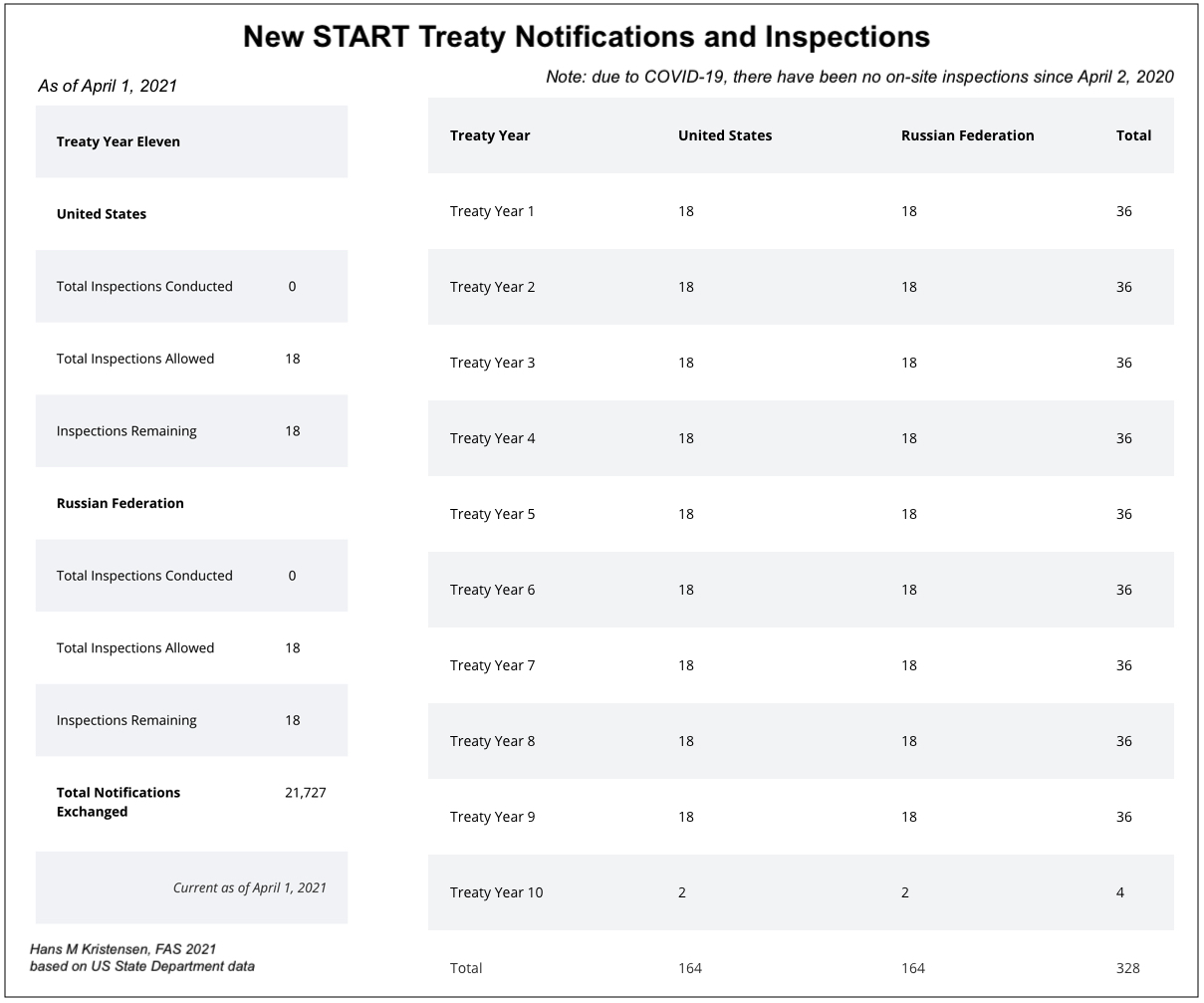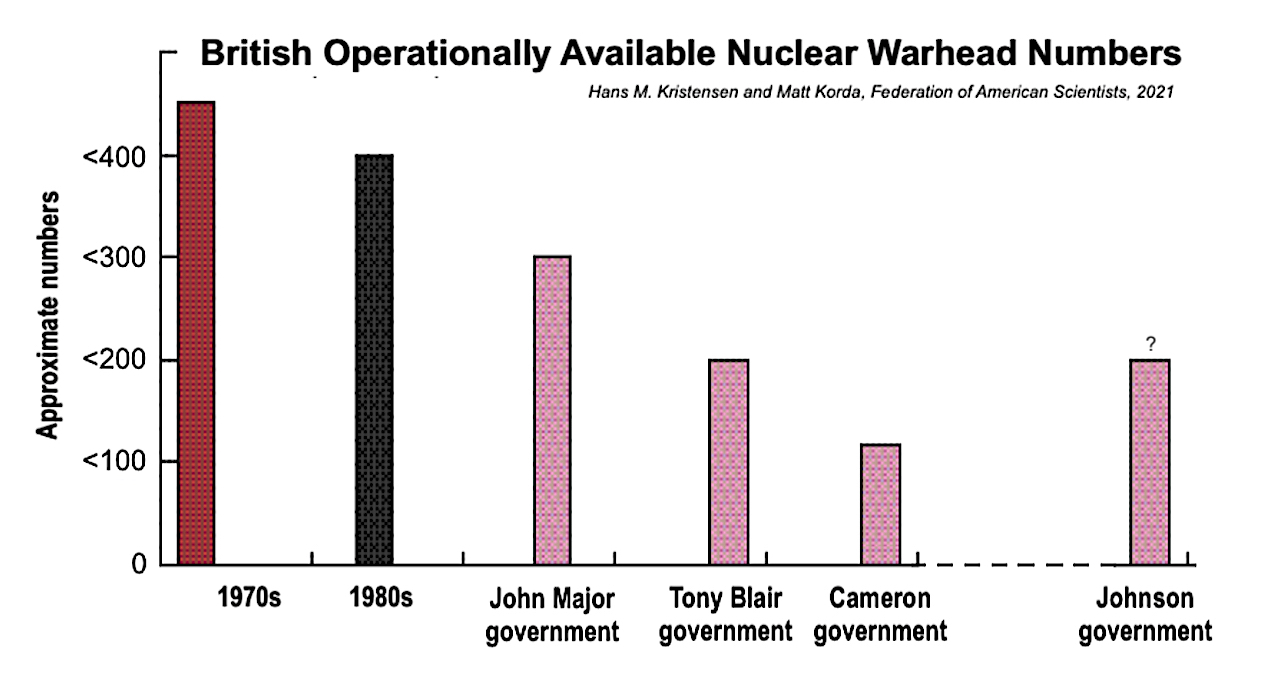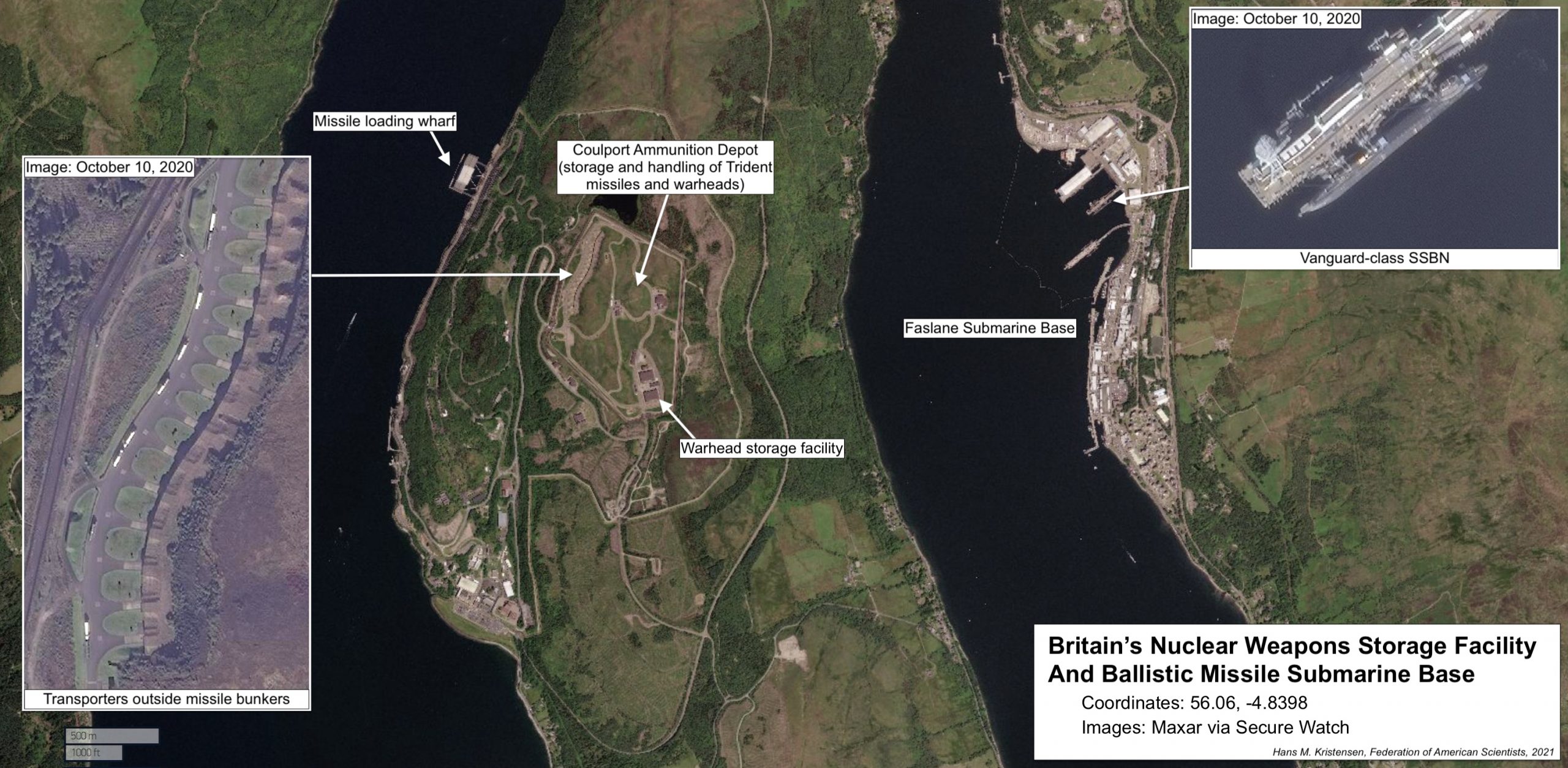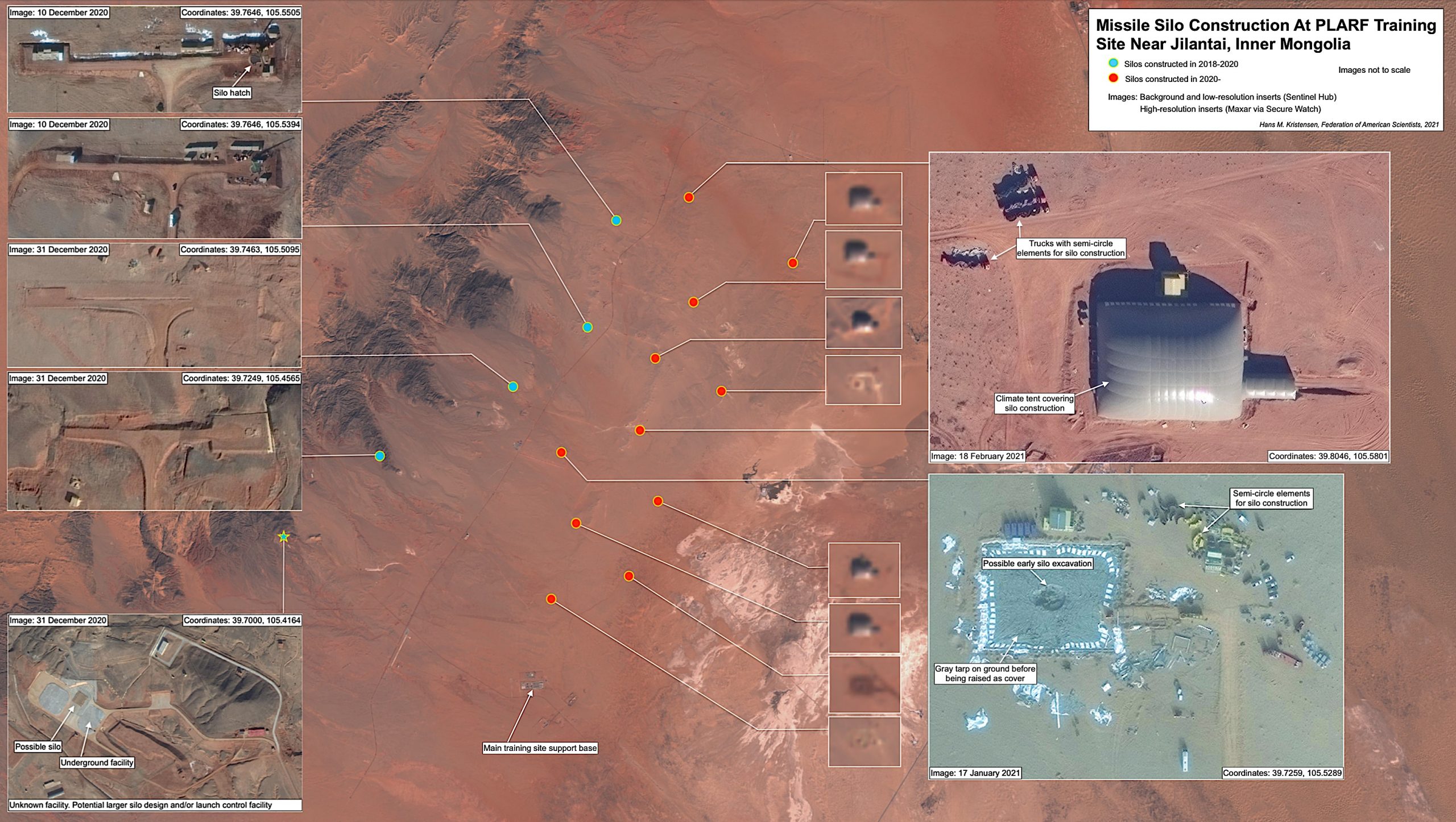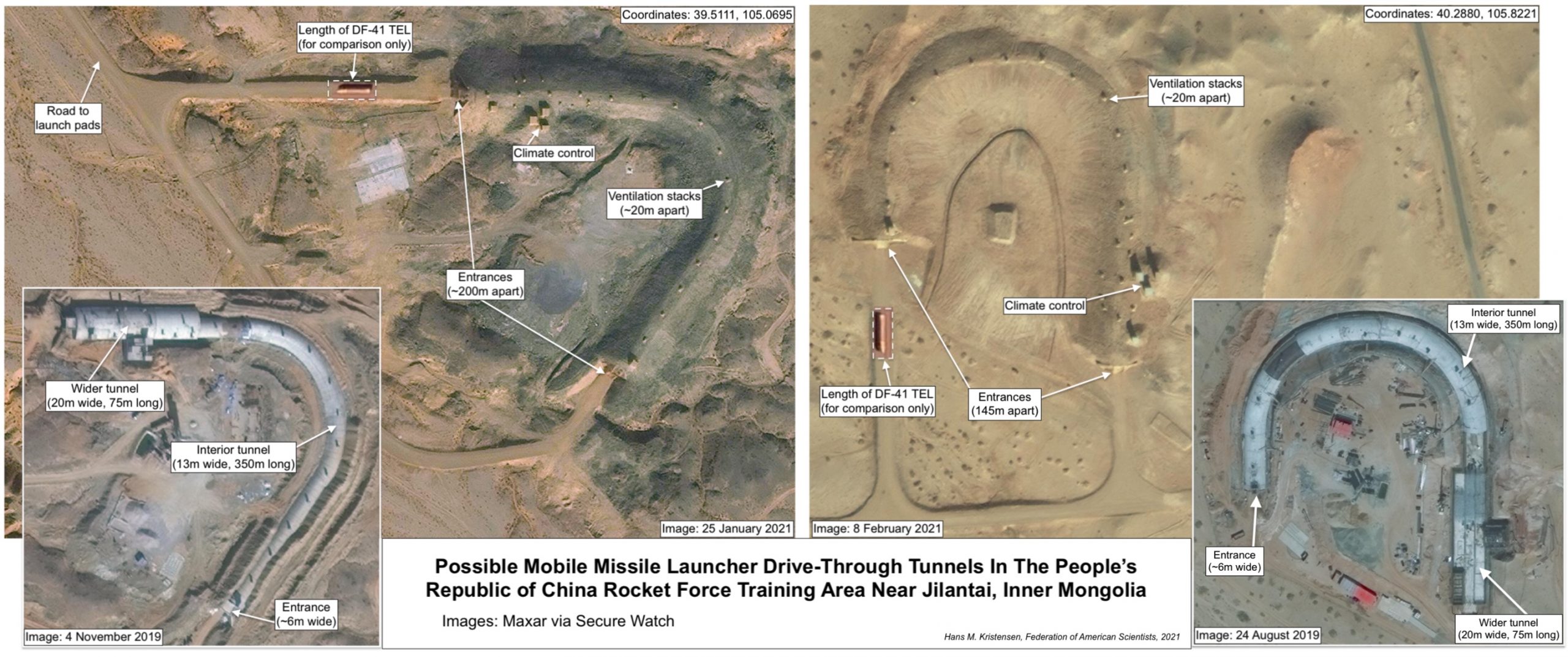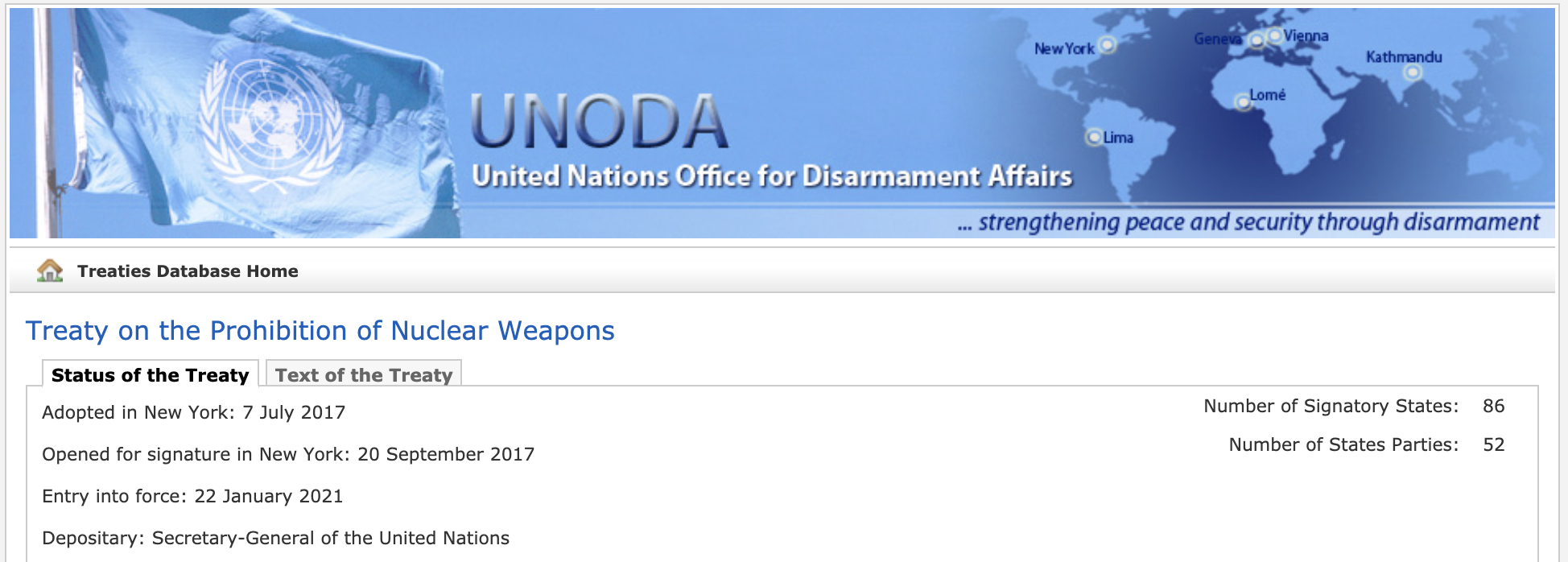China Is Building A Second Nuclear Missile Silo Field
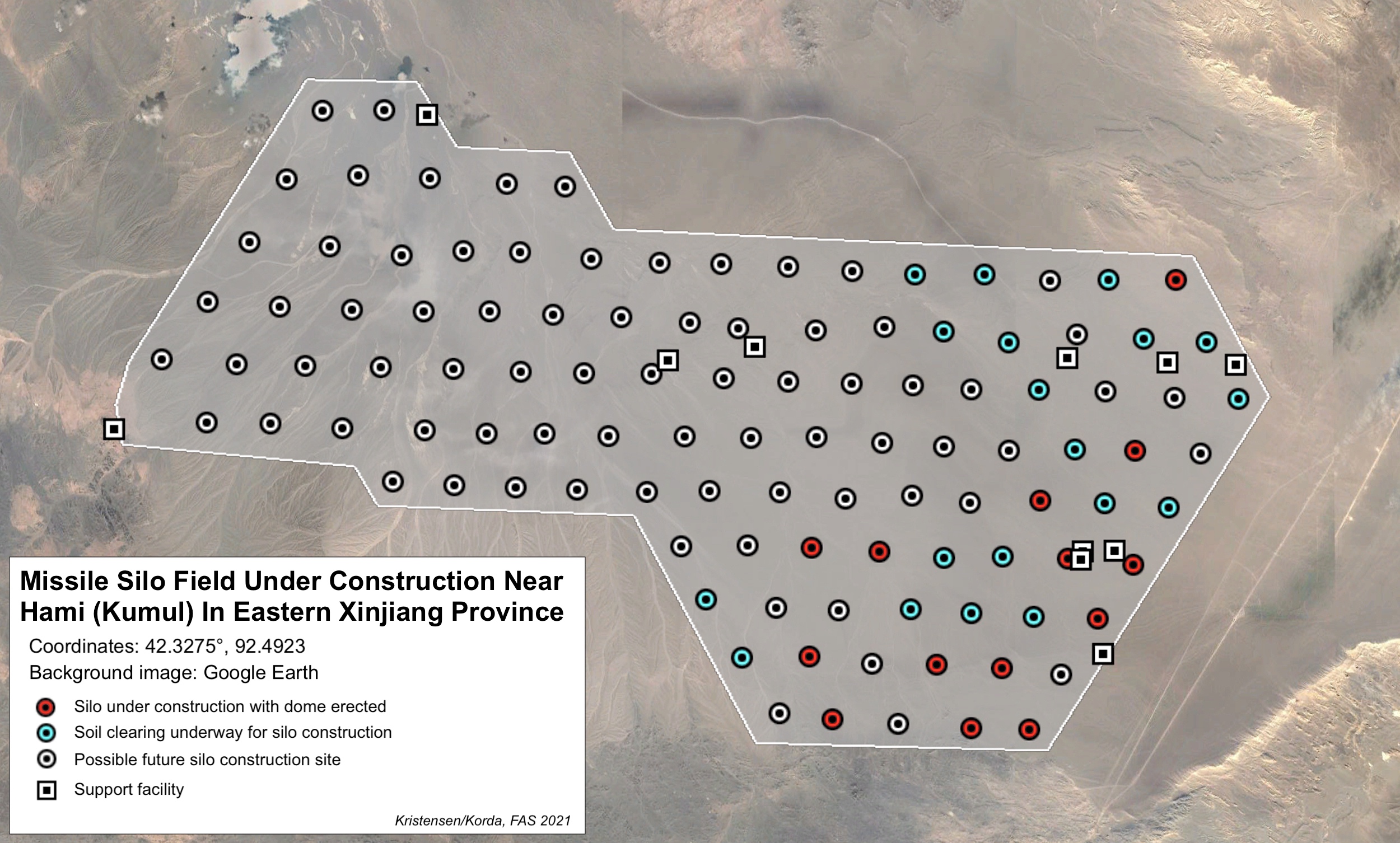
The Hami missile silo field covers an area of about 800 square kilometers and is in the early phases of construction.
Satellite images reveal that China is building a second nuclear missile silo field. The discovery follows the report earlier this month that China appears to be constructing 120 missile silos near Yumen in Gansu province. The second missile silo field is located 380 kilometers (240 miles) northwest of the Yumen field near the prefecture-level city of Hami in Eastern Xinjiang.
The Hami missile silo field is in a much earlier stage of development than the Yumen site. Construction began at the start of March 2021 in the southeastern corner of the complex and continues at a rapid pace. Since then, dome shelters have been erected over at least 14 silos and soil cleared in preparation for construction of another 19 silos. The grid-like outline of the entire complex indicates that it may eventually include approximately 110 silos.
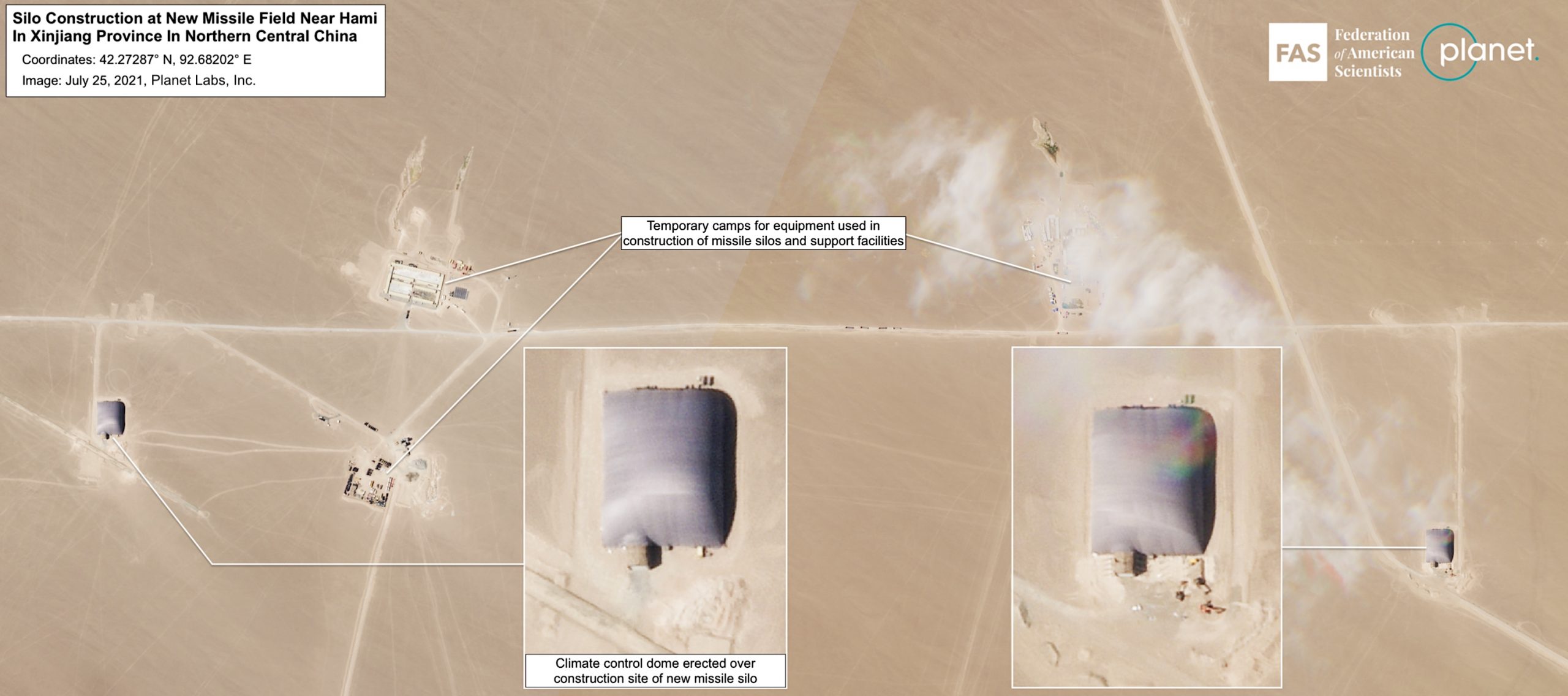
Dome structures have been erected over 14 silo construction sites. Preparation is underway for another 19, and the entire missile field might eventually include 110 silos.
The Hami site was first spotted by Matt Korda, Research Associate for the Nuclear Information Project at the Federation of American Scientists, using commercial satellite imagery. Higher resolution images of the site were subsequently provided by Planet.
The silos at Hami are positioned in an almost perfect grid pattern, roughly three kilometers apart, with adjacent support facilities. Construction and organization of the Hami silos are very similar to the 120 silos at the Yumen site, and are also very similar to the approximately one-dozen silos constructed at the Jilantai training area in Inner Mongolia. These shelters are typically removed only after more sensitive construction underneath is completed. Just like the Yumen site, the Hami site spans an area of approximately 800 square kilometers.
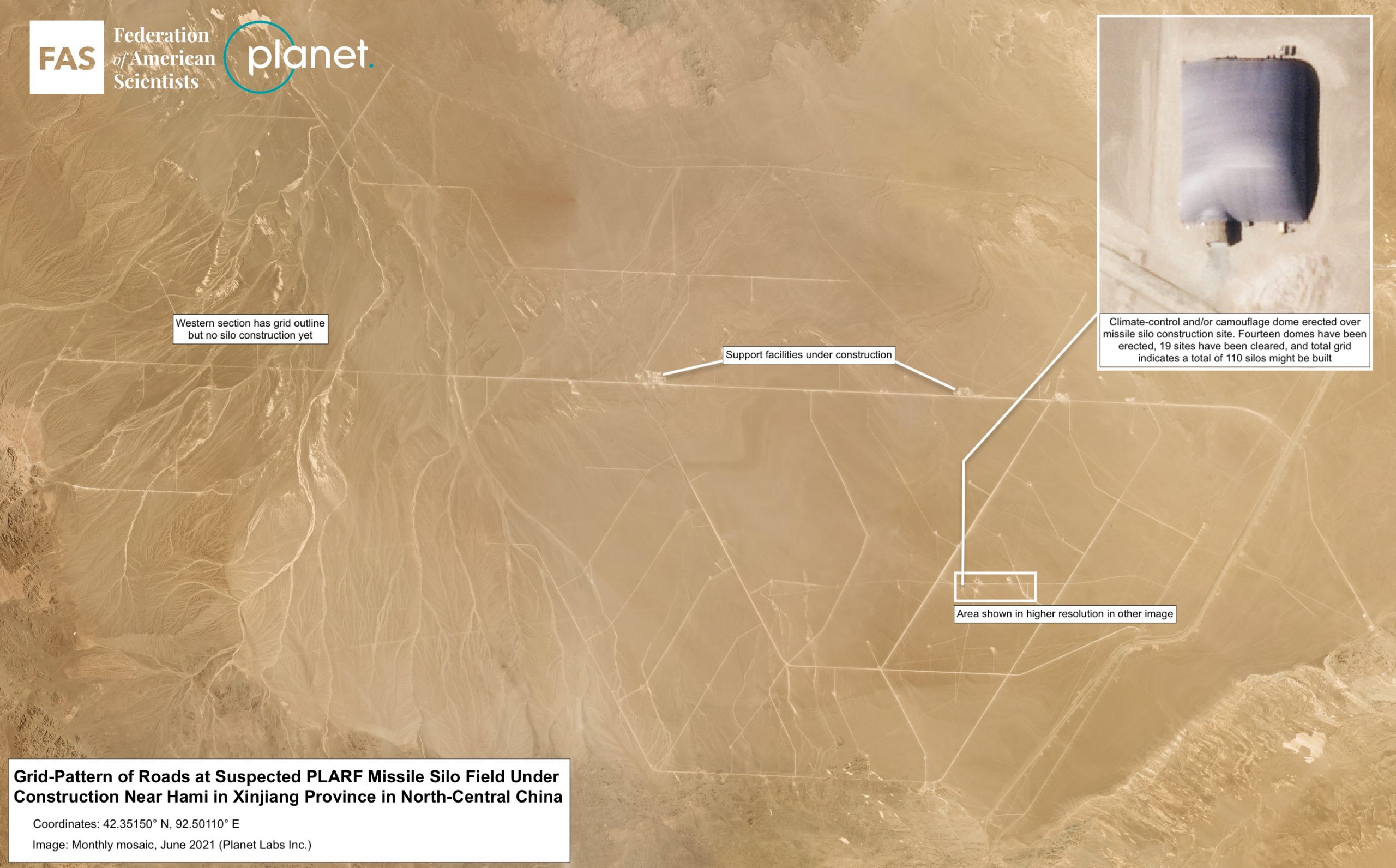
The Hami missile silo field has a grid-pattern where the silos are located approximately 3 kilometers from each other.
Impact on the Chinese nuclear arsenal
The silo construction at Yumen and Hami constitutes the most significant expansion of the Chinese nuclear arsenal ever. China has for decades operated about 20 silos for liquid-fuel DF-5 ICBMs. With 120 silos under construction at Yumen, another 110 silos at Hami, a dozen silos at Jilantai, and possibly more silos being added in existing DF-5 deployment areas, the People’s Liberation Army Rocket Force (PLARF) appears to have approximately 250 silos under construction – more than ten times the number of ICBM silos in operation today.
The number of new Chinese silos under construction exceeds the number of silo-based ICBMs operated by Russia, and constitutes more than half of the size of the entire US ICBM force. The Chinese missile silo program constitutes the most extensive silo construction since the US and Soviet missile silo construction during the Cold War.
The 250 new silos under construction are in addition to the force of approximately 100 road-mobile ICBM launchers that PLARF deploys at more than a dozen bases. It is unclear how China will operate the new silos, whether it will load all of them with missiles or if a portion will be used as empty decoys. If they are all loaded with single-warhead missiles, then the number of warheads on Chinese ICBMs could potentially increase from about 185 warheads today to as many as 415 warheads. If the new silos are loaded with the new MIRVed DF-41 ICBMs, then Chinese ICBMs could potentially carry more than 875 warheads (assuming 3 warheads per missile) when the Yumen and Hami missile silo fields are completed.
It should be emphasized that it is unknown how China will operate the new silos and how many warheads each missile will carry. Regardless, the silo construction represents a significant increase of the Chinese arsenal, which the Federation of American Scientists currently estimates includes approximately 350 nuclear warheads. The Pentagon stated last year that China had “an operational nuclear warhead stockpile in low-200s,” and STRATCOM commander Adm. Charles Richard said early this year that “China’s nuclear weapons stockpile is expected to double (if not triple or quadruple) over the next decade.” The new silos could allow China to accomplish this goal, if it is indeed the goal.
Although significant, even such an expansion would still not give China near-parity with the nuclear stockpiles of Russia and the United States, each of whom operate nuclear warhead stockpiles close to 4,000 warheads.
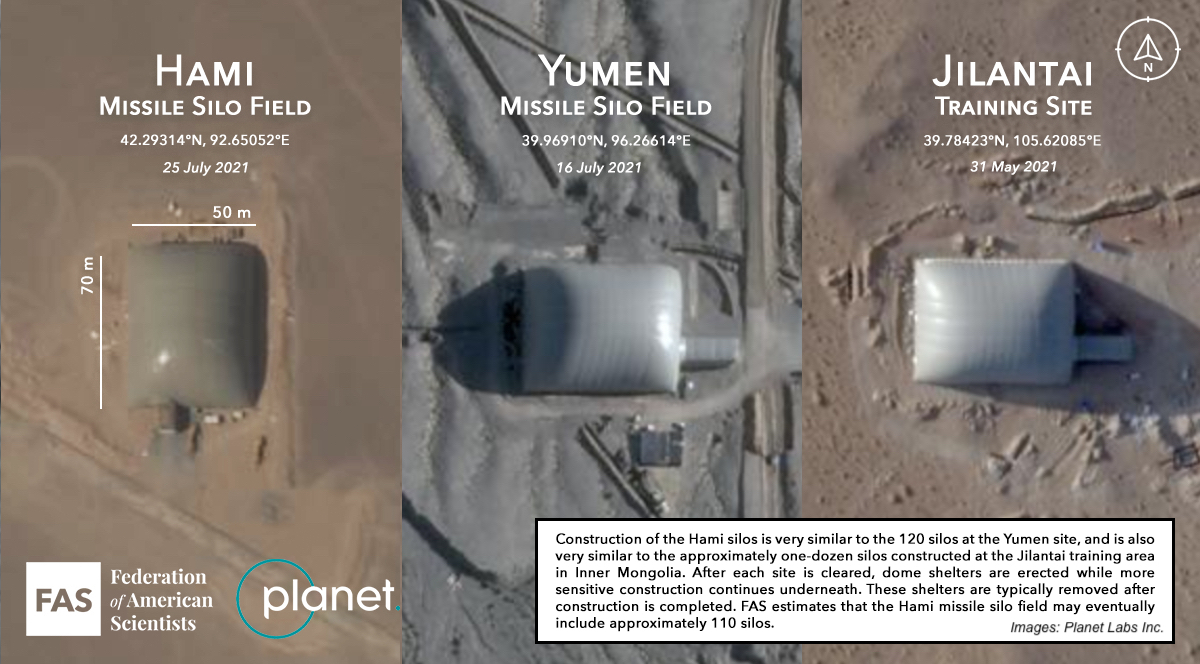
The Hami missile silo field domes are identical to silo domes seen at the Yumen missile silo field and the Jilantai training area.
Chinese motivations
There are several possible reasons why China is building the new silos. Regardless of how many silos China ultimately intends to fill with ICBMs, this new missile complex represents a logical reaction to a dynamic arms competition in which multiple nuclear-armed players––including Russia, India, and the United States––are improving both their nuclear and conventional forces as well as missile defense capabilities. Although China formally remains committed to its posture of “minimum” nuclear deterrence, it is also responding to the competitive relationship with countries adversaries in order to keep its own force survivable and capable of holding adversarial targets at risk. Thus, while it is unlikely that China will renounce this policy anytime soon, the “minimum” threshold for deterrence will likely continue to shift as China expands its nuclear arsenal. The decision to build the large number of new silos has probably not been caused by a single issue but rather by a combination of factors, listed below in random order:
Ensuring survivability of nuclear retaliatory capability: China is concerned that its current ICBM silos are too vulnerable to US (or Russian) attack. By increasing the number of silos, more ICBMs could potentially survive a preemptive strike and be able to launch their missiles in retaliation. China’s development of its current road-mobile solid-fuel ICBM force was, according to the US Central Intelligence Agency, fueled by the US Navy’s deployment of Trident II D5 missiles in the Pacific. This action-reaction dynamic is most likely a factor in China’s current modernization.
Increasing the readiness of the ICBM force: Transitioning from liquid-fuel missiles to solid-fuel missiles in silos will increase the reaction-time of the ICBM force.
Protecting ICBMs against non-nuclear attack: All existing DF-5 silos are within range of US conventional cruise missiles. In contrast, the Yumen and Hami missile silo fields are located deeper inside China than any other Chinese ICBM base (see map below) and out of reach of US conventional missiles.
Overcoming potential effects of US missile defenses: Concerns that missile defenses might undermine China’s retaliatory capability have always been prominent. China has already decided to equip its DF-5B ICBM with multiple warheads (MIRV); each missile can carry up to five. The new DF-41 ICBM is also capable of MIRV and the future JL-3 SLBM will also be capable of carrying multiple warheads. By increasing the number of silos-based solid-fuel missiles and the number of warheads they carry, China would seek to ensure that they can continue to penetrate missile defense systems.
Transitioning to solid-fuel silo missiles: China’s old liquid-fuel DF-5 ICBMs take too long to fuel before they can launch, making them more vulnerable to attack. Handling liquid fuel is also cumbersome and dangerous. By transitioning to solid-fuel missile silos, survivability, operational procedures, and safety of the ICBM force would be improved.
Transitioning to a peacetime missile alert posture: China’s missiles are thought to be deployed without nuclear warheads installed under normal circumstances. US and Russian ICBMs are deployed fully ready and capable of launching on short notice. Because military competition with the United States is increasing, China can no longer be certain it would have time to arm the missiles that will need to be on alert to improve the credibility of China deterrent. The Pentagon in 2020 asserted that the silos at Jilantai “provide further evidence China is moving to a LOW posture.”
Balancing the ICBM force: Eighty percent of China’s roughly 110 ICBMs are mobile and increasing in numbers. The US military projects that number will reach 150 with about 200 warheads by 2025. Adding more than 200 silos would better balance the Chinese ICBM force between mobile and fixed launchers.
Increasing China’s nuclear strike capability: China’s “minimum deterrence” posture has historically kept nuclear launchers at a relatively low level. But the Chinese leadership might have decided that it needs more missiles with more warheads to hold more adversarial facilities at risk. Adding nearly 250 new silos appears to move China out of the “minimum deterrence” category.
National prestige: China is getting richer and more powerful. Big powers have more missiles, so China needs to have more missiles too, in order to underpin its status as a great power.
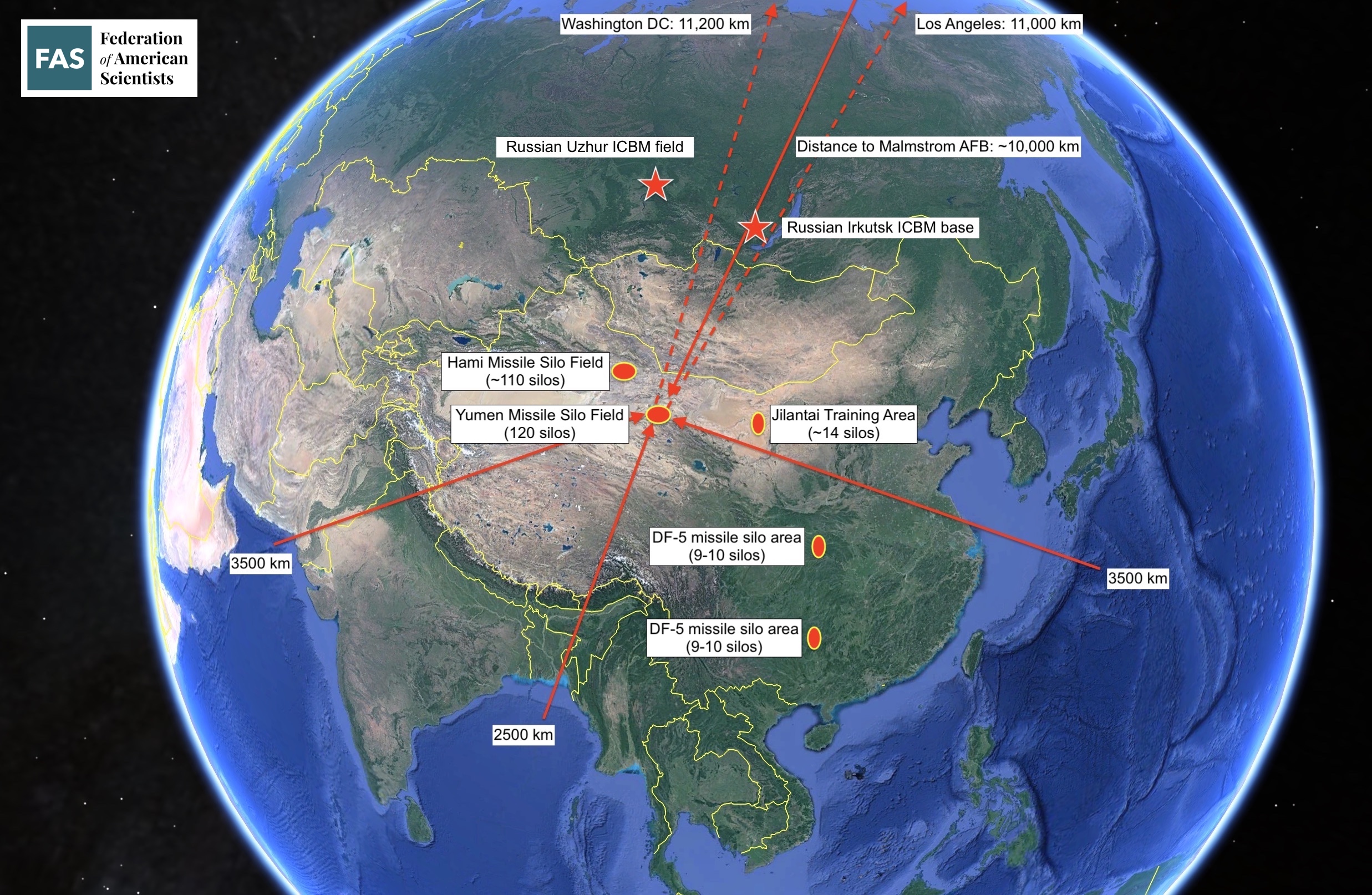
The Hami and Yumen missile silo fields are located deeper inside China than any other ICBM base and beyond the reach of conventional cruise missiles. Click on image to view full size. Image: Google Earth.
What to do about it?
China’s construction of nearly 250 new silos has serious implications for international relations and China’s role in the world. The Chinese government has for decades insisted it has a minimum deterrent and that it is not part of any nuclear arms race. Although it remains unclear how many silos will actually be filled with missiles, the massive silo construction and China’s other nuclear modernization programs are on a scale that appears to contradict these polices: the build-up is anything but “minimum” and appears to be part of a race for more nuclear arms to better compete with China’s adversaries. The silo construction will likely further deepen military tension, fuel fear of China’s intensions, embolden arguments that arms control and constraints are naïve, and that US and Russian nuclear arsenals cannot be reduced further but instead must be adjusted to take into account the Chinese nuclear build-up.
The disclosure of the second Chinese silo missile field comes only days before US and Russian negotiators meet to discuss strategic stability and potential arms control measures. Responding to the Chinese build-up with more nuclear weapons would be unlikely to produce positive results and could cause China build up even more. Moreover, even when the new silos become operational, the Chinese nuclear arsenal will still to be significantly smaller than those of Russia and the United States.
The clearest path to reining in China’s nuclear arsenal is through arms control, but this is challenging. The United States has been trying to engage China on nuclear issues since the late-1990s, but so far with minimal success. Rather than discuss specific limitations on weapon systems, these efforts have been limited to increasing transparency about force structure plans and strategy, and well as discussing nuclear doctrine and intentions.
The Trump administration correctly sought to broaden nuclear arms control to include China, but fumbled the effort by turning it into a public-relations pressure stunt and insisting that China should be part of a New START treaty extension. Beijing not surprisingly rejected the effort, and Chinese officials have plainly stated that “it is unrealistic to expect China to join [the United States and Russia] in a negotiation aimed at nuclear arms reduction,” particularly while China’s arsenal remains a fraction of the size.
Bringing China and other nuclear-armed states into a sustained arms control dialogue will require a good-faith effort that will require the United States to clearly articulate what it is willing to trade in return for limits on Chinese forces. In this regard, it is worth noting that the absence of limits on US missile defenses is of particular and longstanding concern to both China and Russia. When the Bush administration decided to withdraw from the Anti-Ballistic Missile Treaty in 2002, officials from both countries explicitly stated that the treaty’s demise would be highly destabilizing, and implied that they would take steps to offset this perceived US advantage. Nearly 20 years later, the knock-on effects of this decision are clear. Putting US missile defenses on the negotiating table could help clear the path towards enacting a new arms control agreement that ultimately keeps both Chinese and Russian nuclear arsenals in check.
But the Chinese nuclear modernization is driven by more than just missile defenses. This includes the nuclear modernization programs of the United States, India, and Russia, the significant enhancements of the conventional forces of those countries and their allies, as well as China’s own ambitions about world power status.
Later this year (or early next year) the parties to the nuclear Non-Proliferation Treaty (NPT) will meet to review the progress of the treaty. Although the treaty does not explicitly prohibit a country from modernizing or even increasing its nuclear arsenal, reduction and eventually elimination of nuclear weapons are key pillars of the treaty’s goal as reaffirmed by numerous previous NPT conferences. It is difficult to see how adding nearly 250 nuclear missile silos is consistent with China’s obligation to “pursue negotiations in good faith on effective measures relating to cessation of the nuclear arms race at an early date and to nuclear disarmament…”
Background information:
- China Expanding Missile Training Area: More Silos, Tunnels, and Support Facilities
- Chinese nuclear forces, 2021 (SIPRI Yearbook)
- The Pentagon’s 2020 China Report
Our Hami missile silo discovery was first featured in the New York Times on 26 July 2021.
This publication was made possible by generous support from the John D. and Catherine T. MacArthur Foundation, the New Land Foundation, the Ploughshares Fund, and the Prospect Hill Foundation. The statements made and views expressed are solely the responsibility of the author.
Nuclear Secrecy: In Defense of Reform
One of the stranger features of nuclear weapons secrecy is the government’s ability to reach out and classify nuclear weapons-related information that has been privately generated without government involvement. This happened most recently in 2001.
The roots of this constitutionally questionable policy are investigated in Restricted Data, a book by science historian Alex Wellerstein that sheds new light on the origins and development of nuclear secrecy.
One might suppose that nuclear secrecy is merely incidental to the larger history of nuclear weapons, but Wellerstein demonstrates that the subject is rich and dynamic and consequential enough to merit a history of its own.
He traces nuclear secrecy back to the Manhattan Project (or shortly before) when the most basic questions were first posed: what is a nuclear secret? what is the role of “information” in creating nuclear weapons? what can secrecy accomplish and what are its hazards? when and how are secrets to be disclosed?
Answers to such questions naturally varied. The basic idea of the atomic bomb did not actually involve any secrets, according to physicist Hans Bethe. But when it came to the hydrogen bomb, he said, “this time we have a real secret to protect.”
Wellerstein is not just an accomplished historian who has done his archival homework, he is also a lively storyteller. And he leavens his narrative with surprising observations and insights. We learn, for example, that Aleksandr Solzhenitsyn read a copy of the official Smyth Report on the atomic bomb while on his way to the Gulag. Elsewhere Wellerstein writes that declassification can be a way of reinforcing classification: “the release of some information [is] used to uphold the importance of not releasing other information. . . . disclosure could be a form of control as well.”
Challenges to nuclear secrecy quickly came from many directions: Soviet spies, recalcitrant scientists, careless bureaucrats, and eventually “anti-secrecy” activists.
Wellerstein devotes a particularly engaging chapter to the “anti-secrecy” efforts of Howard Morland, the late Chuck Hansen, and Bill Arkin who all, for their own diverse reasons, defied or circumvented secrecy controls.
He gives less focused attention to more conventional attempts to reform and reduce nuclear secrecy, which he seems to consider less significant than the antagonistic efforts to discover classified matters.
Maybe because I was present on the periphery of the Openness Initiative led by Secretary of Energy Hazel O’Leary in 1993-97, I found Wellerstein’s treatment of it to be somewhat cursory and understated. From my perspective, the O’Leary Openness Initiative represented the single biggest discontinuity in the history of nuclear secrecy since the 1945 Smyth Report that first described the production of the atomic bomb.
Within a fairly short period of time, O’Leary declassified and disclosed (as Wellerstein notes) a complete list of nuclear explosive tests and their yields; inventories of highly enriched uranium and weapons-grade plutonium; most of the previously classified research on inertial confinement fusion; and a wealth of other historical and contemporary nuclear weapons-related information that had been sought by researchers and advocates. The final report of a year-long Fundamental Classification Policy Review launched by O’Leary and intended to reboot classification policy somehow did not make it into Wellerstein’s notes or bibliography. A copy is here.
Outside critics of secrecy who join the government will often adapt themselves to the status quo, Wellerstein writes. They find that secrecy is “sticky” and hard to dislodge. Yet O’Leary dislodged it repeatedly.
The date of her 1993 Openness press conference — it was December 7 — remains fresh in memory because a Washington Times columnist called it “the most devastating single attack on the underpinnings of the U.S. national security structure since Japan’s lightning strike” on Pearl Harbor. That can’t have been pleasant for her. But O’Leary came back and did it again with more declassified disclosures a few months later. And then again.
So one lesson for secrecy reform that emerges from the O’Leary Openness Initiative is that it matters who is in charge. Given a choice between an opportunity to wordsmith a classification policy regulation or to select an agency head who is committed to open government, it is clear what the right move would be. Good policy statements can be ignored or subverted. Good leaders will often get the job of reform done.
A second lesson here is that “nuclear secrecy” is not an undifferentiated mass of information and that not all nuclear secrets are equally important or equally in demand.
O’Leary’s use of the management jargon of “stakeholders” reflected the reality that different groups had different interests in reducing nuclear secrecy and that different secrets were sought by each. Environmentalists wanted environmental information. Laser fusion scientists wanted fusion technology. Arms controllers wanted stockpile data. Historians wanted other things. And so on. Interestingly, there was also plenty of stuff that no one wanted. There is a good deal of classified technical data that has little or no policy relevance or historical significance — or that everyone agrees is properly withheld.
It can be difficult to think clearly about nuclear secrecy and to set aside what one wishes were true in order to acknowledge what actually appears to be the case. As startling and unprecedented as O’Leary’s disclosures were, the lasting impact of the Openness Initiative was limited, as Wellerstein assesses. Her disclosures were not reversed (they couldn’t be), but her successors resembled her predecessors more than they resembled her. What’s worse is that mere “facts” like those that she released seem to have less traction on the political process than ever before.
Wellerstein does an outstanding job of explaining how we got where we are today, and his analysis will help inform where we might realistically hope to go in the future. Restricted Data is bound to be the definitive work on the history of nuclear secrecy.
* * *
Last month marked 30 years since the classified Pentagon nuclear rocket program codenamed Timberwind was disclosed without authorization. See “Secret Nuclear-Powered Rocket Being Developed for ‘Star Wars'” by William J. Broad, New York Times, April 3, 1991.
In those days before the world wide web and the proliferation of online news and opinion, the story’s appearance on the front page of the New York Times (“above the fold”) commanded wide attention and soon led to formal declassification of the program followed by its termination.
* * *
There is no shortage of secrets remaining at the Department of Energy, according to one recent account. See “If You Want To Hide A Classified Program, Try The Department Of Energy” by Brett Tingley, The Drive: The Warzone, May 13.
First New START Data After Extension Shows Compliance
The first public release of New START aggregate numbers since the United States and Russia in February extended the agreement for five years shows the treaty continues to limit the two nuclear powers strategic offensive nuclear forces.
Continued adherence to the New START limits is one of the few positive signs in the otherwise frosty relations between the two countries.
The ten years of aggregate data published so far looks like this:
Combined Forces
The latest set of this data shows the situation as of March 1, 2021. As of that date, the two countries possessed a combined total of 1,567 accountable strategic missiles and heavy bombers, of which 1,168 launchers were deployed with 2,813 warheads. That is a slight decrease in the number of deployed launchers and warheads compared with six months ago (note: the combined warhead number is actually about 100 too high because each deployed bomber is counted as one weapon even though neither country’s bombers carry weapons under normal circumstances).
Compared with September 2020, the data shows the two countries combined increased the total number of strategic launchers by 3, decreased combined deployed strategic launchers by 17, and decreased the combined deployed strategic warheads by 91. Of these numbers, only the “3” is real; the other changes reflect natural fluctuations as launchers move in and out of maintenance or are being upgraded.
In terms of the total effect of the treaty, the data shows the two countries since February 2011 combined have cut 422 strategic launchers from their arsenals, reduced deployed strategic launchers by 235, and reduced the number of deployed strategic warheads by 524. However, it is important to remind that this warhead reduction is but a fraction (just over 6 percent) of the estimated 8,297 warheads that remain in the two countries combined nuclear weapons stockpiles (just over 4 percent if counting their total combined inventories of 11,807 stockpiled and retired (but yet to be dismantled) warheads).
The United States
The data shows the United States currently possessing 800 strategic launchers, exactly the maxim number allowed by the treaty, of which 651 are deployed with 1,357 warheads attributed to them. This is a decrease of 24 deployed strategic launchers and 100 deployed strategic warheads over the past 6 months. These are not actual decreases but reflect normal fluctuations caused by launchers moving in and out of maintenance. The United States has not reduced its total inventory of strategic launchers since 2017.
The aggregate data does not reveal how many warheads are attributed to the three legs of the triad. The full unclassified data set will be released later. But if one assumes the number of deployed bombers and deployed ICBMs are the same as in the September 2020 data, then the SSBNs carry 909 warheads on 200 deployed Trident II SLBMs. That is a decrease of 100 warheads on the SSBN force compared with September, or an average of 4-5 warheads per deployed missile. Overall, this accounts for 67 percent of all the 1,357 warheads attributed to the deployed strategic launchers (nearly 70 percent if excluding the “fake” 50 bomber weapons included in the official count).

The New START data indicates that the United States as of March 1, 2021 deployed approximately 909 warheads on ballistic missile onboard its strategic submarines.
Compared with February 2011, the United States has reduced its inventory of strategic launchers by 324, deployed launchers by 231, and deployed strategic warheads by 443. While important, the warhead reduction represents only a small fraction (about 12 percent) of the 3,800 warheads that remain in the U.S. stockpile (less than 8 percent if counting total inventory of 5,800 stockpiled and retired (but yet to be dismantled) warheads).
The Russian Federation
The New START data shows Russia with an inventory of 767 strategic launchers, of which 517 are deployed with 1,456 warheads attributed to them. Compared with six months ago, this is an increase of 7 deployed launchers and 9 deployed strategic warheads. The change reflects fluctuations caused by launcher maintenance and upgrade work to new systems.
Compared with February 2011, Russia has cut its inventory of strategic launchers by 98, deployed launchers by 4, and deployed strategic warheads by 81. This modest warhead reduction represents less than 2 percent of the estimated 4,497 warheads that remain in Russia’s nuclear weapons stockpile (only 1.3 percent if counting the total inventory of 6,257 stockpiled and retired (but yet to be dismantled) Russian warheads).
Compared with 2011, the Russian reductions accomplished under New START are smaller than the U.S. reductions because Russia had fewer strategic forces than the United States when the treaty entered into force in 2011.
Build-up, What Build-up?
With frequent claims by U.S. officials that Russia is increasing its nuclear arsenal, which may be happening in some categories, it is interesting that despite a significant modernization program, the New START data shows this increase is not happening in the size of Russia’s accountable strategic nuclear forces. (The number of strategic-range nuclear forces outside New START is minuscule.)
On the contrary, the New START data shows that Russia has 134 deployed strategic launchers less than the United States, a significant gap roughly equal to the number of missiles in an entire US Air Force ICBM wing. It is significant that Russia despite its modernization programs so far has not sought to reduce this gap by deploying more strategic launchers. Instead, the Russian launcher deficit has been increasing by nearly one-third since its lowest point in February 2018.
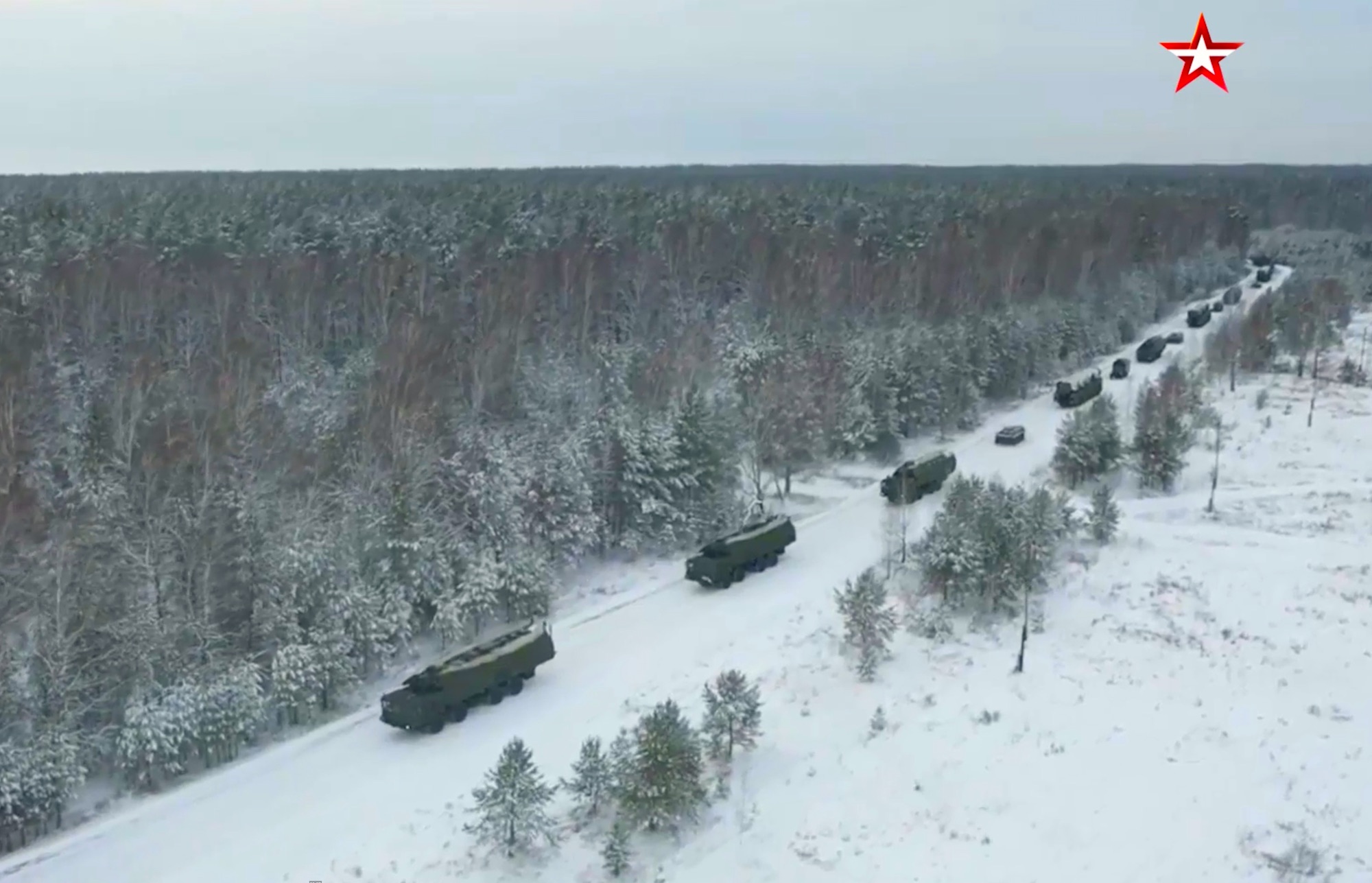
Although Russia is modernizing its nuclear forces, such as those of this SS-27 Mod 2 (RS-24, Yars) ICBM exercise near Bernaul, this has not yet resulted in an increase of its strategic nuclear weapons.
Instead, the Russian military appears to try to compensate for the launcher disparity by increasing the number of warheads that can be carried on the newer missiles (SS-27 Mod 2, Yars, and SS-N-32, Bulava) that are replacing older types (SS-25, Topol, and SS-N-18, Vysota). Thanks to the New START treaty limit, many of these warheads are not deployed on the missiles under normal circumstance but are stored and could potentially be uploaded onto the launchers in a crisis. The United States also has such an upload capability for its larger inventory of launchers and therefore is not at a strategic disadvantage.
Two of Russia’s new strategic nuclear weapons (SS-19 Mod 4, Avangard, and SS-29, Sarmat) are covered by New START if formally incorporated. Other types (Poseidon nuclear-powered torpedo, and Burevestnik nuclear-powered ground-launched cruise missile) are not yet deployed and appear to be planned in relatively small numbers. They do not appear capable of upsetting the strategic balance in the foreseeable future. The treaty includes provisions for including new weapon types, if the two sides agree.
Inspections and Notifications
In addition to the New START data, the U.S. State Department has also updated the overview of part of its treaty verification activities. The data shows that the two sides since February 2011 have carried out 328 on-site inspections of each other’s strategic nuclear forces and exchanged 21,727 notifications of launcher movements and activities. Nearly 860 of those notifications were exchanged since September 2020.
Importantly, due to the Coronavirus outbreak, there have been no on-site inspections conducted since April 1, 2020. Instead, notification exchanges and National Technical Means of verification have provided adequate verification. Nonetheless, on-site inspection can hopefully be resumed soon.
This inspection and notification regime and record are crucial parts of the treaty and increasingly important for U.S.-Russian strategic relations as other treaties and agreements have been scuttled.
Looking Ahead
Although the New START treaty has been extended for five years and it appears to be working, that is no reason to be complacent. The United States and Russia should undertake detailed and ongoing negotiations about what a follow-on treaty will look like, so they are ready well before the five-year extension runs out. The incompetent and brinkmanship negotiation style of the Trump administration fully demonstrated the risks and perils of waiting to the last minute. The Biden administration can and should do better.
Additional information:
This publication was made possible by generous support from the John D. and Catherine T. MacArthur Foundation, the New Land Foundation, the Ploughshares Fund, and the Prospect Hill Foundation. The statements made and views expressed are solely the responsibility of the author.
The U.S. Intercontinental Ballistic Missile Force: A Post-Cold War Timeline
The Pentagon is currently planning to replace its current arsenal of intercontinental ballistic missiles (ICBMs) with a brand-new missile force, known as the Sentinel (previously called the Ground Based Strategic Deterrent, or GBSD); it was previously estimated to cost approximately $100 billion in acquisition fees and $264 billion throughout its lifecycle until 2075 (in Then-Year dollars); however, the price tag has since risen substantially, calling the program’s future into question.
Below, you will find a comprehensive timeline of all relevant actions taken relating to the ICBM force since the end of the Cold War, including force posture alterations, international treaties, congressional efforts, government studies, and milestones in the Sentinel acquisition process.
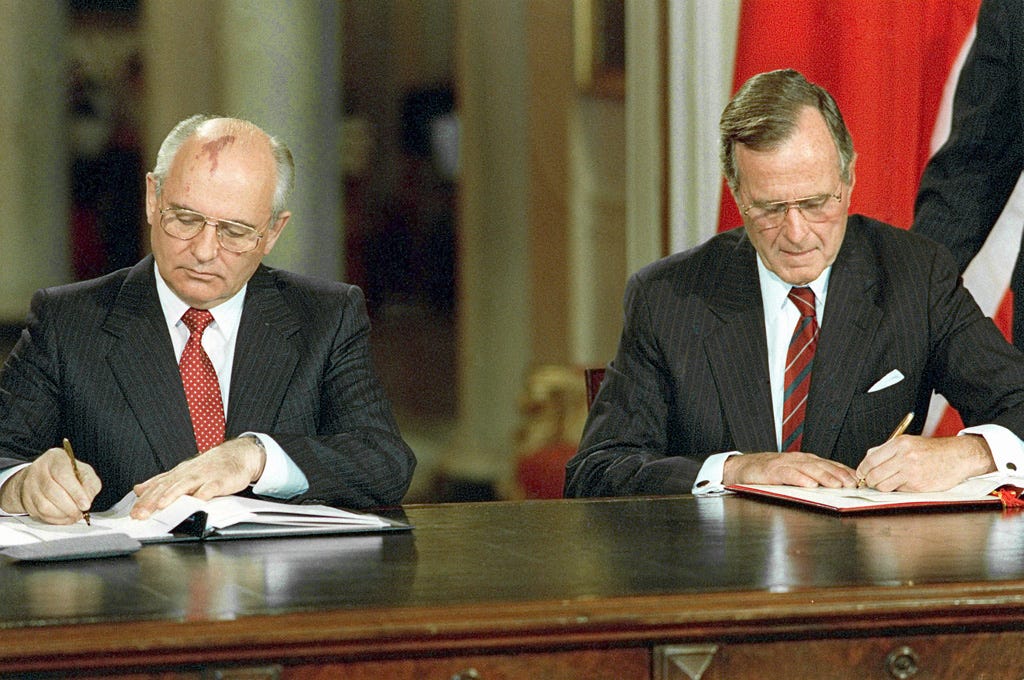
The United States and Soviet Union sign the START Treaty.
START prohibited each country from deploying more than 6,000 nuclear warheads deployed on up to 1,600 strategic delivery vehicles. At the time, the United States’ ICBM force comprised 450 single-warhead Minuteman IIs, 500 three-warhead Minuteman IIIs, and 50 ten-warhead Peacekeeper MX missiles––for a total of 2,450 warheads attributed to 1,000 ICBMs.
27 September 1991
President Bush announces the de-alerting and eventual retirement of all 450 Minuteman II ICBMs.
With the Cold War coming to a close, President Bush took the first steps toward reducing the United States’ land-based nuclear force under the direction of the newly-signed START Treaty.
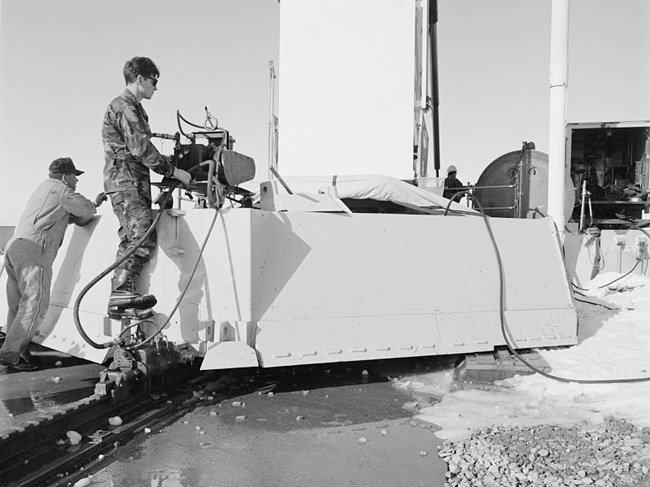
The first Minuteman II ICBM is removed from Ellsworth Air Force Base’s Golf-02 silo near Red Owl, South Dakota.
The last Minuteman II ICBM at Ellsworth Air Force Base was withdrawn from its silo in April 1994, and the 44th Missile Wing became formally inactive in July 1994.
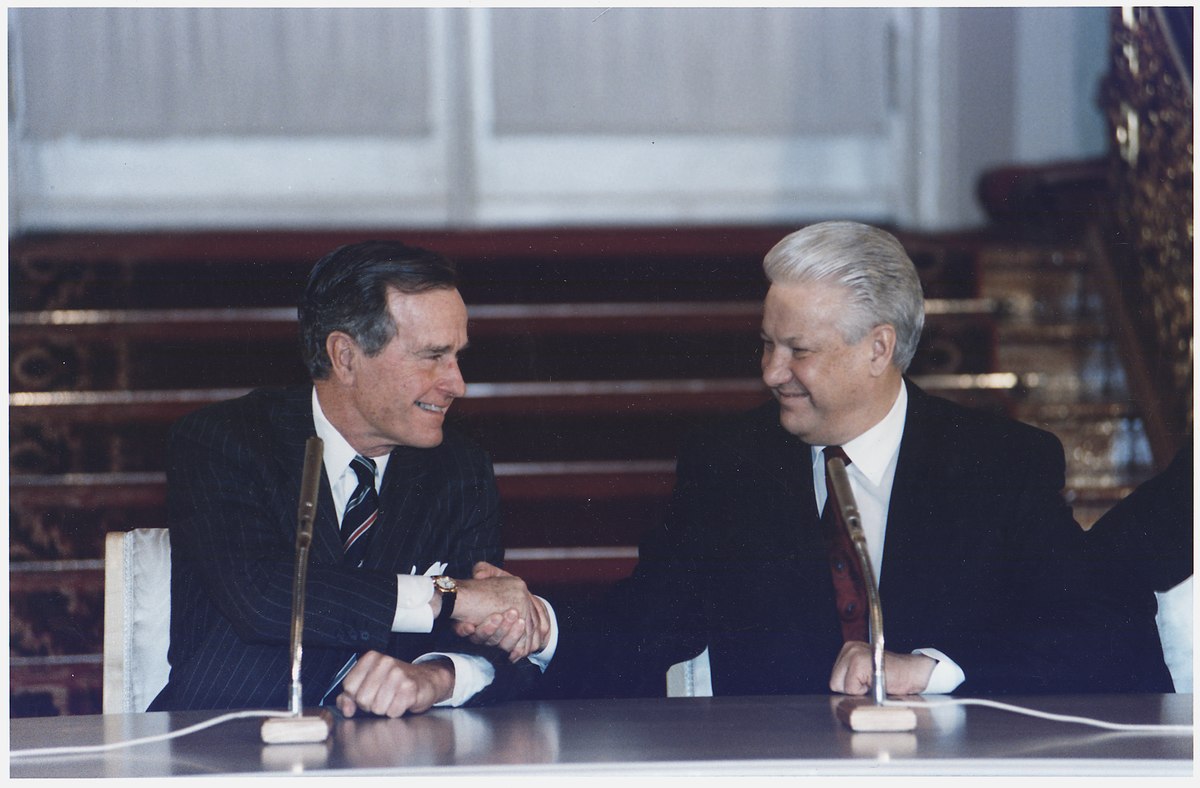
The United States and Russia sign the START II Treaty.
In order to comply with START II’s ban on ICBMs with multiple independently targetable reentry vehicles (MIRVs), the Pentagon planned to retire its 50 Peacekeeper MX ICBMs and de-MIRV its Minuteman III fleet, for an expected future ICBM force of 500 warheads attributed to 500 Minuteman III ICBMs; however, START II never entered into force. After the Strategic Offensive Reductions Treaty (SORT) was signed in 2002, President George Bush eventually did retire the Peacekeepers and download many of the MIRV’ed warheads from the Minuteman III force.
June 1993
GAO publishes an evaluation of the proposed Minuteman III Guidance Replacement Program.
At the time, the Air Force hoped to begin replacing the Minuteman III’s guidance systems with upgraded versions. The GAO’s evaluation, titled” Minuteman III Guidance Replacement Program Had Not Been Adequately Justified,” noted that the Air Force’s own assessments “are not identifying any Minuteman III missile guidance set system-level performance concerns. To the contrary, for the last several years the Minuteman III missile guidance set flight reliability has improved.”
The study further assessed that “missile guidance set failure rates have remained at an acceptable level, with no adverse failure rate trends,” and quoted a previous Air Force study which suggested that “there is no conclusive evidence of degradation within the Minuteman III missile guidance set that cannot be corrected on a case-by-case basis.”
Ultimately, Congress chose to fully fund the $1.6 billion program, which was completed in December 2008.
10 June 1993
GAO publishes its evaluation of the US nuclear modernization program.
The GAO’s evaluation included several notable passages:
p. 5: “We found that the Soviet threat to the weapon systems of the land and sea legs had also been overstated. For the sea leg, this was reflected in unsubstantiated allegations about likely future breakthroughs in Soviet submarine detection technologies, along with underestimation of the performance and capabilities of our own nuclear-powered ballistic missile submarines. The projected threat to the sea leg was, however, used frequently as a justification for costly modernizations in the other legs to ‘hedge’ against SSBN vulnerability. Our specific finding, based on operational test results, was that submerged SSBNs are even less detectable than is generally understood, and that there appear to be no current or long-term technologies that would change this. Moreover, even if such technologies did exist, test and operational data show that the survivability of the SSBN fleet would not be in question.”
pp. 6-7, 14: “Compared to ICBMs, no operationally meaningful difference in time to target was found,” further noting that “SSBNs are in essentially constant communication with national command authorities and, depending on the scenario, SLBMs from submarine platforms would be almost as prompt as ICBMs in hitting enemy targets.”
pp. 7-8: “In comparing performance and cost across the legs and weapon systems of the triad, we were concerned to find little or no prior recent effort by DOD to do what we were doing––that is, evaluate comprehensively the relative effectiveness of similar weapon systems. Yet such agency evaluation is critical if limited budget dollars are to be concentrated on programs that are both needed and effective. With regard to proposed upgrades, we found many instances of dubious support for claims of their high performance; insufficient and often unrealistic testing; understated cost; incomplete or unrepresentative reporting; lack of systematic comparison against the systems they were to replace; and unconvincing rationales for their development in the first place. Where mature programs were concerned, on the other hand, we often found that their performance was understated and that inappropriate claims of obsolescence had been made. […] Perhaps the most important point here is that comparative evaluation across the three legs of the triad–and between individual weapon systems and their proposed upgrades–has been signally lacking. This is unfortunate because it deprives policymakers in both the executive branch and the Congress of information they need for making decisions involving hundreds of billions of dollars.”
p. 14: Nuclear “[command, control, and communications] to SSBNs is about as prompt and as reliable as to ICBMs, under a range of conditions.”
1994
The Clinton administration releases its Nuclear Posture Review.
The first comprehensive review of the United States’ nuclear posture in the post-Cold War era was launched by the Department of Defense under Secretary Les Aspin. The Clinton administration’s Nuclear Posture Review working groups, convened by future Secretary of Defense Ash Carter, considered several proposals that would have eliminated the ICBM force entirely––including Carter’s suggestion to adopt a “monad” of 10 submarines carrying 24 Trident missiles with six warheads each––however, these proposals were quickly shot down. Ultimately, it was decided that ICBMs would remain part of the US nuclear deterrent.
5 December 1994
The START Treaty enters into force.
The START Treaty, signed three years earlier, was the first post-Cold War bilateral arms control treaty to reduce global nuclear arsenals and resulted in an 80 percent reduction of all strategic nuclear weapons in the world at the time of its implementation. The treaty expired in December 2009 and would later be replaced by New START, which was signed by the United States and Russia in 2010.
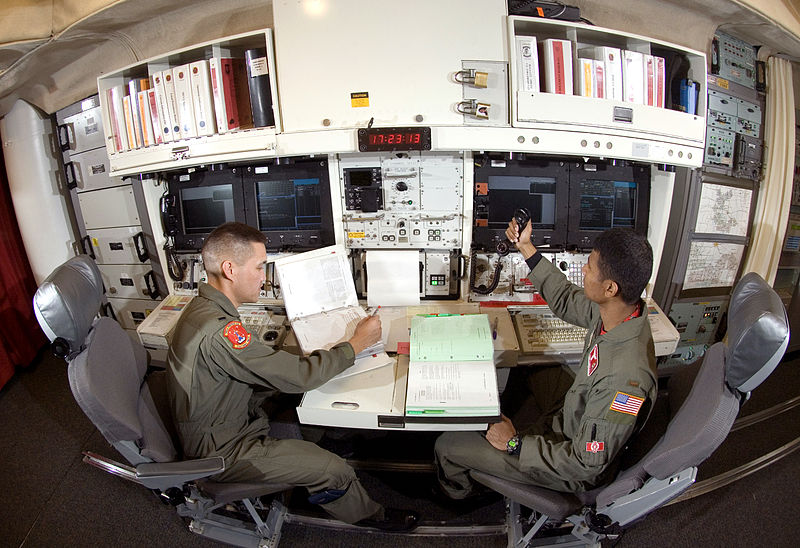
Rapid Execution and Combat Targeting (REACT) upgrade program completed.
The REACT system, originally conceived in the early 1980s, made it possible to retarget the entire Minuteman fleet in under ten hours, and––most critically––allowed missileers to continuously retarget individual missiles as necessary. Although the upgrade was painted at the time as primarily a means of reducing crew fatigue, it also further entrenched the idea of nuclear weapons as “flexible” tools that could be called upon in warfighting scenarios––a strain of thought that continues to dominate nuclear deterrence thinking to this day.
15 December 1997
The Minuteman II elimination process is completed.
The last Minuteman II silo––Hotel-11, near Dederick, Montana––was imploded on 15 December 1997, formally completing the Minuteman II elimination process.
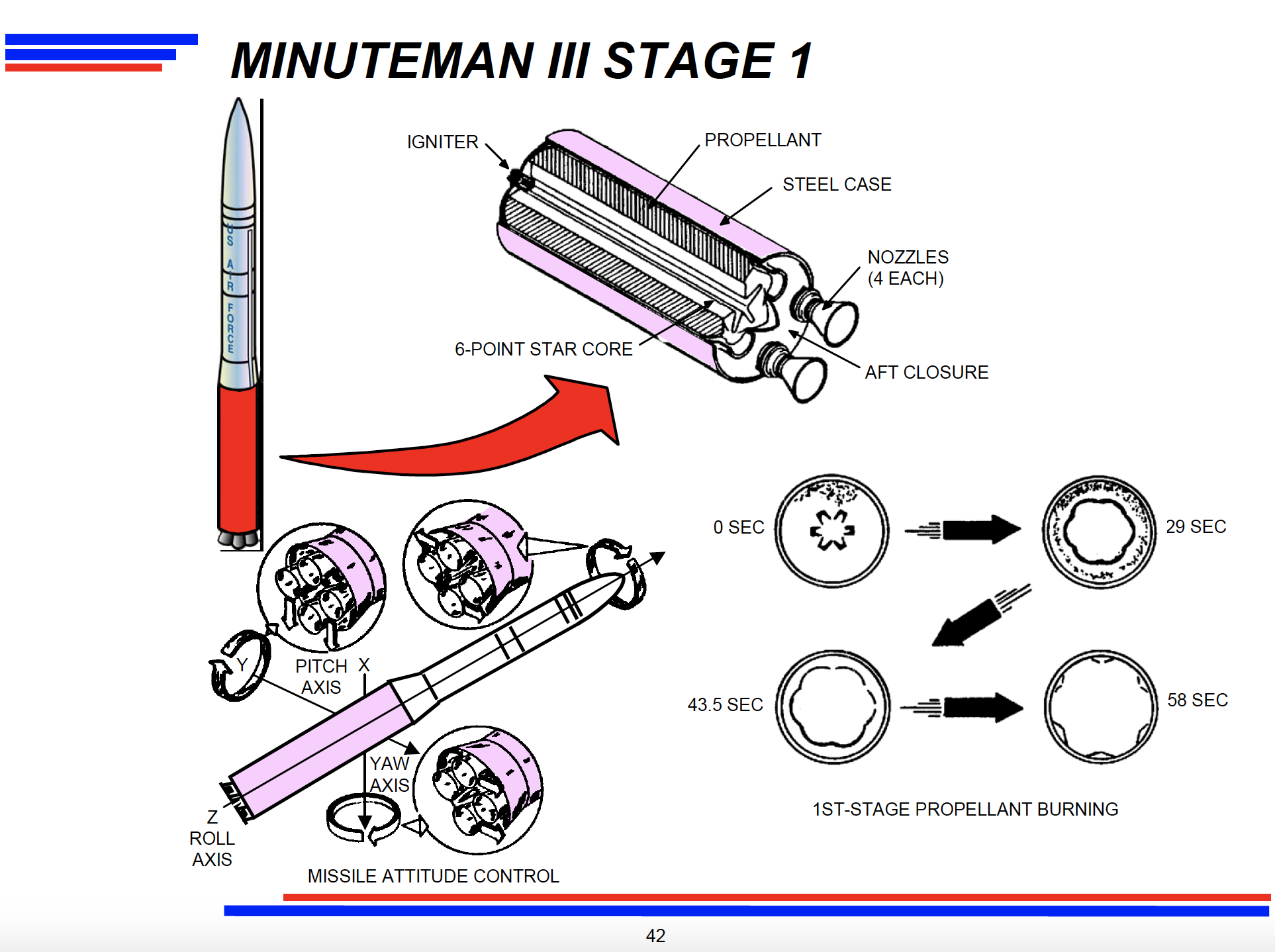
Propulsion Replacement Program (PRP) begins.
The PRP was a life-extension program for the Minuteman III that extended the service lives of approximately 600 solid rocket motors by re-manufacturing all three stages. The first PRP-extended missile was deployed at Malmstrom in April 2001.*
*David K. Stumpf, Minuteman: A Technical History of the Missile That Defined American Nuclear Warfare (Fayetteville: University of Arkansas Press, 2020), p. 395.
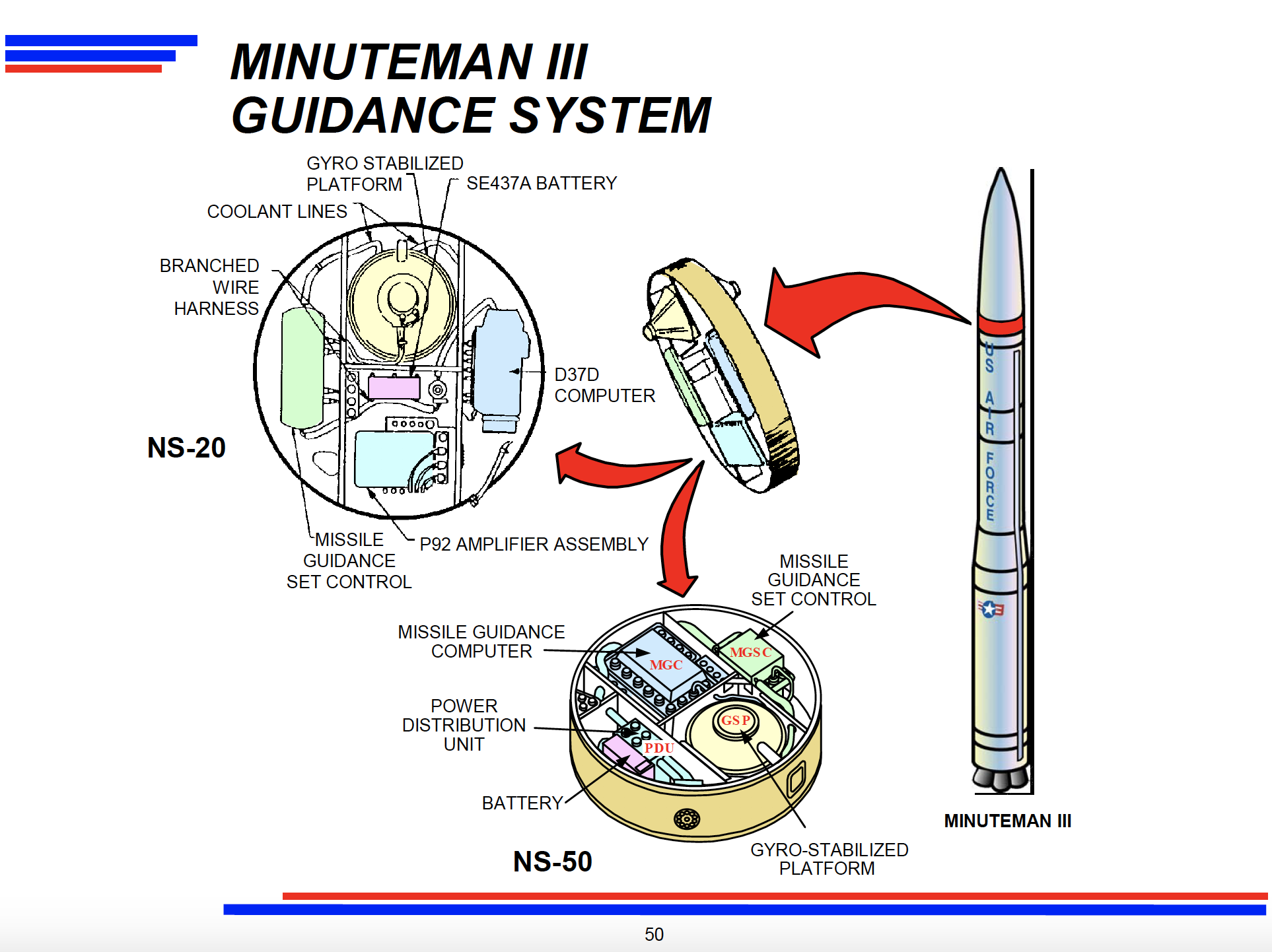
Guidance Replacement Program (GRP) begins.
The GRP was a life-extension program for the Minuteman III that replaced both the electronic components of the missile guidance set control and the inertial measurement instruments contained within the gyro-stabilized platform.* The first GRP missile was installed on 3 August 1999 in launch facility I-09 at Malmstrom Air Force Base.**
*David Spires, On Alert: An Operational History of the United States Air Force Intercontinental Ballistic Missile Program, 1945-2011 (Colorado Springs: United States Air Force, 2012), p. 174.
**David K. Stumpf, Minuteman: A Technical History of the Missile That Defined American Nuclear Warfare (Fayetteville: University of Arkansas Press, 2020), p. 397.

Propulsion System Rocket Engine (PSRE) life-extension program begins.
The PSRE life-extension program was initiated in February 2000 to sustain the Minuteman III missiles’ post-boost propulsion system. The program included the manufacture of 586 PSRE modification kits and cost approximately $107 million to complete.*
*David K. Stumpf, Minuteman: A Technical History of the Missile That Defined American Nuclear Warfare (Fayetteville: University of Arkansas Press, 2020), p. 395.
8 January 2002
Bush administration publishes its Nuclear Posture Review.
This review established a “New Triad” composed of nuclear and non-nuclear offensive strike systems, active and passive defenses, and a responsive defense infrastructure. The report also called for a reduction in the US nuclear arsenal.
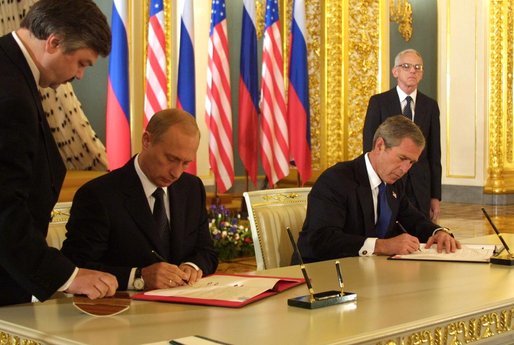
The United States and Russia sign the Strategic Offensive Reductions Treaty (SORT).
Both parties agreed to reduce their nuclear arsenals to between 1,700 and 2,200 operationally deployed warheads each. SORT entered into force on June 1, 2003, and was eventually superseded by the New START Treaty.
October 2002
The Air Force begins to decommission all 50 Peacekeeper ICBMs.
After almost twenty years of service, the LGM-118 Peacekeeper (MX) was phased out as part of the START II agreement (later bypassed by the SORT Treaty) with Russia.
September 2005
The Air Force deactivates the last remaining Peacekeeper ICBM.
As part of the Peacekeeper deactivation, the rockets were converted and repurpose for exploratory space missions (satellite launchers) and the W87 warheads were deployed on the Minuteman III missiles.
6 February 2006
Quadrennial Defense Review announces the reduction of the deployed Minuteman III force from 500 to 450.
The Department of Defense released the QDR in the fifth year of the War in Afghanistan. This review promoted the “New Triad” strategy proposed by the 2002 Nuclear Posture review and emphasized more tailorable approaches to deterrence. The QDR also announced the elimination of 50 additional ICBMs from service, for a remaining force of 450 ICBMs.

Rapid Execution and Combat Targeting (REACT) Service Life-Extension Program (SLEP) completed.
This upgrade modified the Minuteman launch control centers to combine the communications system and weapons system into one console, thereby reducing the number of keys for a launch and the time needed to retarget the ICBM force. The effort was identified as “essential to the future nuclear force,” according to the 2002 Nuclear Posture Review.*
*David Spires, On Alert: An Operational History of the United States Air Force Intercontinental Ballistic Missile Program, 1945-2011 (Colorado Springs: United States Air Force, 2012), p. 178.
October 2006
As part of the SERV program, the Minuteman III three-warhead MIRVs were converted to the single Mk21 reentry vehicles that were previously carried by the Peacekeeper missile. The first SERV Minuteman III was deployed with the 90th Missile Wing at F.E. Warren Air Force Base and placed on alert on 1 January 2007.*
*David K. Stumpf, Minuteman: A Technical History of the Missile That Defined American Nuclear Warfare (Fayetteville: University of Arkansas Press, 2020), p. 396.
17 October 2006
Congress passes the FY 2007 Defense Appropriations Act.
Sec. 139 directs the Secretary of the Air Force to “modernize Minuteman III intercontinental ballistic missiles in the United States inventory as required to maintain a sufficient supply of launch test assets and spares to sustain the deployed force of such missiles through 2030.” This amendment proved to be incredibly 18 consequential because, as Air Force historian David N. Spires describes, “Although Air Force leaders had asserted that incremental upgrades, as prescribed in the analysis of land-based strategic deterrent alternatives, could extend the Minuteman’s life span to 2040, the congressionally mandated target year of 2030 became the new standard.”*

*David Spires, On Alert: An Operational History of the United States Air Force Intercontinental Ballistic Missile Program, 1945-2011 (Colorado Springs: United States Air Force, 2012), pp. 184-185.
12 July 2007
The Air Force begins to deactivate the 50 Minuteman III ICBMs scheduled for retirement.
The 564th Missile Squadron, colloquially known as the “Odd Squad,” used different communications and launch control systems from the rest of the Minuteman III force, and was therefore a clear candidate for decommissioning. The entire decommissioning process was completed in approximately one year, with the final Minuteman III removed from its silo on 28 July 2008.*
*David Spires, On Alert: An Operational History of the United States Air Force Intercontinental Ballistic Missile Program, 1945-2011 (Colorado Springs: United States Air Force, 2012), p. 185-186.
December 2008
Guidance Replacement Program (GRP) completed.
The final GRP missile was installed on 18 February 2008 with the 90th Missile Wing at F.E. Warren Air Force Base, and Boeing delivered the final upgraded missile guidance set to the Air Force in December 2008.*
*David K. Stumpf, Minuteman: A Technical History of the Missile That Defined American Nuclear Warfare (Fayetteville: University of Arkansas Press, 2020), p. 397.
7 August 2009
Creation of the Air Force Global Strike Command (AFGSC).
With major command headquarters at Barksdale Air Force Base, Louisiana, AFGSC is responsible for the three ICBM wings and the entire bomber force. Air Force Global Strike Command is the service component to the United States Strategic Command, and its major command mission was formerly under the direction of Strategic Air Command, which was disestablished in 1992.
November 2009
ICBM Coalition publishes first white paper.
In anticipation of the crucial Senate vote on New START ratification, the white paper implied that the Coalition would deliver the crucial votes to support the treaty if the Obama administration committed to maintaining 450 ICBMs equipped with one warhead each.
March 2010
US Strategic Command sends an ICBM memo to Air Force Global Strike Command calling for an immediate start to a follow-on ICBM.
The memo indicates that the Air Force would have to begin a procurement effort for a follow-on ICBM immediately, if the Air Force planned to deploy it in the 2030 timeframe.*
*Air Force Nuclear Weapons Center, Intelligence and Capabilities Integration Directorate (AFNWC/XR), “Request for Information 12122011” (December 2011), US General Services Administration.
6 April 2010
Obama administration releases its Nuclear Posture Review.
The NPR announced the “deMIRV-ing” of the ICBM force, and called for the Pentagon to begin the Analysis of Alternatives process for a follow-on ICBM in fiscal years 2011 and 2012.
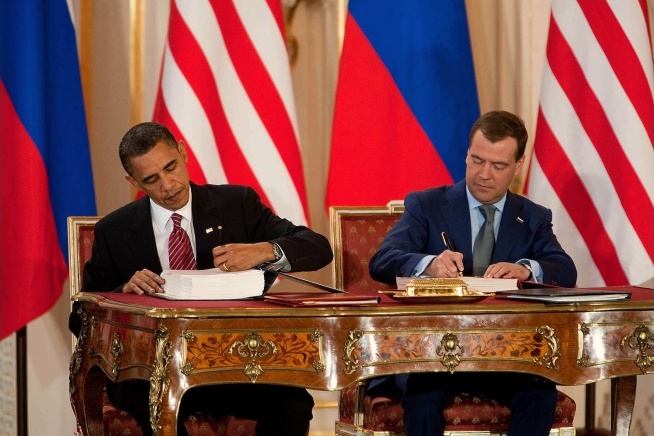
The United States and Russia sign the New START Treaty.
Replacing the START I Treaty, New START placed updated limitations on strategic nuclear arms, including a limit of 1,550 nuclear warheads deployed on no more than 700 strategic delivery vehicles. The treaty was set to have a duration of ten years and was extended in January 2021 for an additional five years.
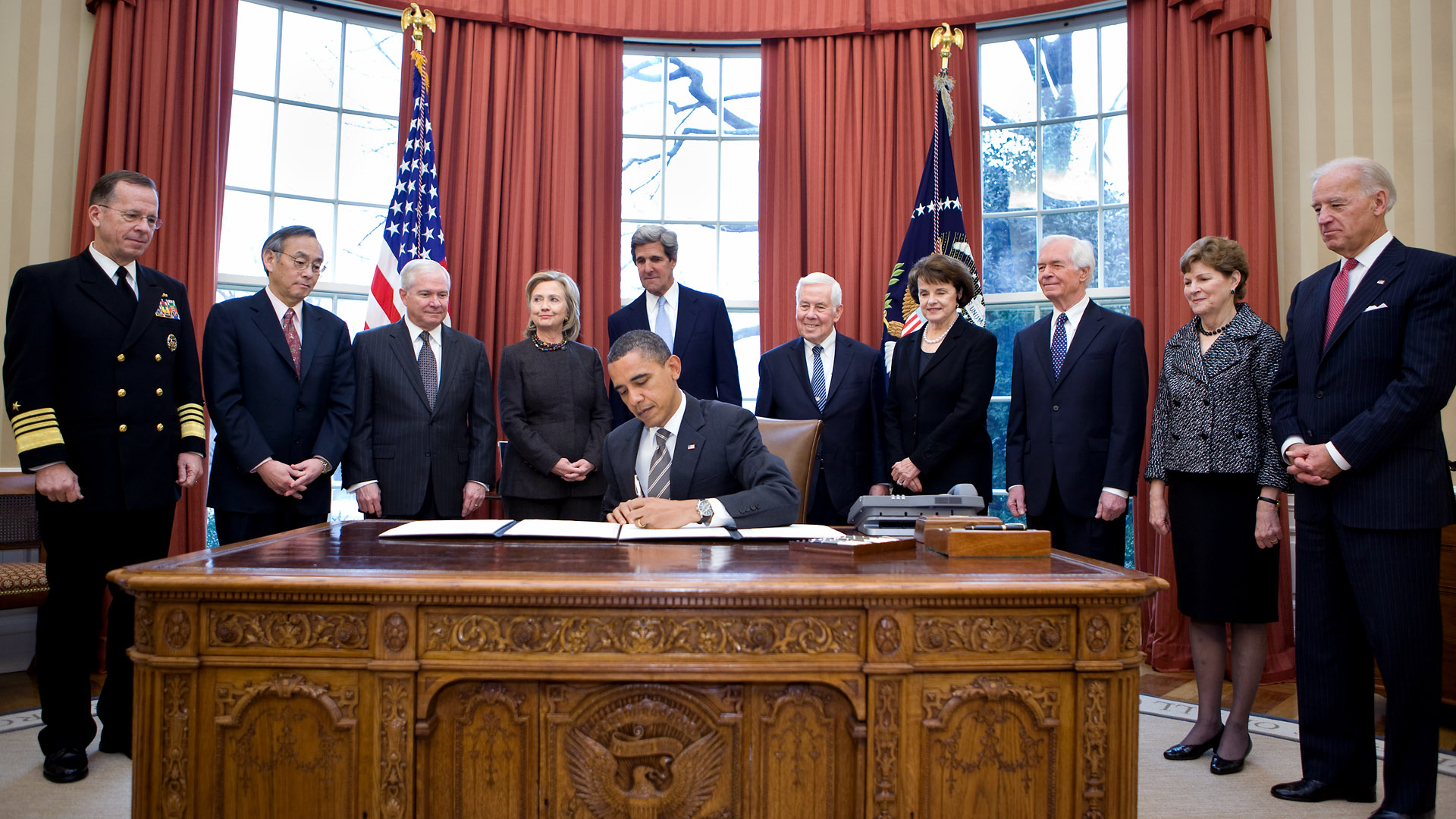
On the same day as the ratification vote, the Obama administration delivered its intended force posture to Congress: the United States would eliminate 30 ICBMs, ultimately retaining a force level of 420 ICBMs with one warhead each. Of the 71 Senators who voted in favor of New START, six of them were members of the Senate ICBM Coalition.
5 February 2011
New START enters into force.
From the date the treaty entered into force, the United States and Russia had seven years to meet the treaty’s central limits on arms reduction. Both parties were in compliance with the central limits in February 2018.
May 2011
Air Force Global Strike Command completes its Capabilities-Based Assessment for the proposed GBSD program.
A Capabilities-Based Assessment (CBA) is one of the earliest elements of the defense acquisition process. It is used to identify the capabilities required to conduct a particular mission, determine whether there are potential capability gaps in the current system and evaluate their associated risks, and provide abstract recommendations for addressing those gaps. This analysis feeds into the subsequent Initial Capabilities Document, which the Air Force completed for the GBSD in May 2012.
December 2011
The Air Force Nuclear Weapons Center issues a Request For Information for the proposed GBSD program.
This RFI – which was based on the conclusions reached in the CBA and still-in-progress Initial Capabilities Document, was intended to solicit “concepts that address modernization or replacement of the ground based leg of the nuclear triad.”* It was one of the first public documents offering significant insight into how the Air Force was imagining the GBSD system at the time. Notably, the Air Force suggested that contractors could “propose innovative deployment and basing strategies, including, but not limited to mobile basing, fixed basing with mobile elements, or hardened silos, in addition to or in place of existing Minuteman III infrastructure.”
*Air Force Nuclear Weapons Center, Intelligence and Capabilities Integration Directorate (AFNWC/XR), “Request for Information RFI-12122011” (December 2011), US General Services Administration.
2012
Safety Enhanced Reentry Vehicle (SERV) conversion for Minuteman III completed.
Although the SERV program was billed as a safety measure due to the new emphasis on configuring the missile fleet with insensitive high explosives, enhanced detonation systems, and other safety features, it also had the practical effect of dramatically improving the Minuteman III’s hard-target kill capability.*
*David Spires, On Alert: An Operational History of the United States Air Force Intercontinental Ballistic Missile Program, 1945-2011 (Colorado Springs: United States Air Force, 2012), pp. 176-178.
May 2012
Joint DOD/DNI Report on Russian strategic forces.
In 2012, the Secretary of Defense and the Director of National Intelligence jointly concluded in a report to Congress that “the only Russian shift in its nuclear forces that could undermine the basic framework of mutual deterrence […] is a scenario that enables Russia to deny the United States the assured ability to respond against a substantial number of highly valued Russian targets following a Russian attempt at a disarming first strike––a scenario that the Department of Defense judges will most likely not occur.”
4 June 2012
An Initial Capabilities Document (ICD) further refines the analysis of the Capabilities-Based Assessment, justifies the need for a material change to the system, and provides a list of capabilities that the proposed new system would need to fulfill. This analysis is required for the acquisition process to proceed. The ICD suggested the following capability requirements for the GBSD: adaptable, effective, flexible, global, reliable, responsive, safe, secure, survivable, sustainable, transportable.

July 2012
Revised US nuclear war plan (OPLAN 8010-12) comes into effect.
As Hans Kristensen suggested at the time, “although very different from the [Cold War-era Single Integrated Operational Plan], OPLAN 8010-12 is still thought to be focused on nuclear warfighting scenarios using a Cold War-like Triad of nuclear forces on high alert to hold at risk and, if necessary, hunt down and destroy nuclear (and to a smaller extent chemical and biological) forces, command and control facilities, military and national leadership, and war supporting infrastructure in a myriad of tailored strike scenarios.”
8 August 2012
The Joint Requirements Oversight Council approves the Air Force’s Initial Capabilities Document and directs it to begin the Analysis of Alternatives process.
The Analysis of Alternatives (AoA) process is a critical component of the defense acquisition process. It compares the effectiveness, suitability, and life-cycle costs of each proposed material solution, and is therefore a key document that influences the system’s ultimate development and acquisition.*
*United States Air Force, “Cost Comparison of Extending the Life of the Minuteman III Intercontinental Ballistic Missile to Replacing it with a Ground-Based Strategic Deterrent: Report to Congress,” Department of Defense (July 2016), p. 4.
2013
President Obama directs the Pentagon to reduce the number of circumstances under which the United States would rely on launch-under-attack.
Jon Wolfsthal, former senior director at the National Security Council for arms control and nonproliferation, subsequently described the implications of this decision as follows: “By openly stating that the United States could, and would, sacrifice its ICBMs in a conflict and still fulfill its missions, the country signaled the reliability and strength of its retaliatory forces.”
2013
Propulsion System Rocket Engine (PSRE) life-extension program completed.
This marked the conclusion of the $107 million contract that the Air Force had awarded to TRW in 2000 for refurbishing the Minuteman III’s liquid-propellant, upper-stage engine that operated during the post-boost phase of flight.*
*David K. Stumpf, Minuteman: A Technical History of the Missile That Defined American Nuclear Warfare (Fayetteville: University of Arkansas Press, 2020), p. 177.
January 2013
The Air Force Nuclear Weapons Center issues a Broad Agency Announcement for the GBSD program.
The Broad Agency Announcement (BAA) is intended to solicit white papers from industry with the purpose of further developing the GBSD design, specifically with an eye towards exploring new basing concepts. In the BAA, the Air Force listed five basing options for further consideration and refinement: “continued use”, “current fixed”, “new fixed”, “new mobile”, and “new tunnel.”*
*Air Force Nuclear Weapons Center, Program Development and Integration Directorate (AFNWC/XZ), “Broad Agency Announcement BAA-AFNWC-XZ-13-001Rev2” (14 January 2013), US General Services Administration.
30 January 2013
Senate ICBM Coalition writes to incoming Secretary of Defense Chuck Hagel, critiquing his participation in Global Zero’s 2012 Nuclear Policy Commission Report, which specifically recommended eliminating US ICBMs.
The eight senators wrote to Hagel requesting a clarification regarding his position on ICBMs in a Global Zero report which Hagel had recently co-authored. The letter inquired as to whether Hagel supported eliminating ICBMs and whether he would support the continuation of the Analysis of Alternatives process for the Ground-Based Strategic Deterrent.
June 2013
The Obama administration completes its review of US nuclear force posture under New START.
Although the administration ultimately concluded that the United States could reduce its deployed strategic forces by up to “one-third”––down to approximately 1,000-1,100 warheads––press reports indicated that the Pentagon contemplated reducing the arsenal to as low as 500 warheads in a plan known as the “deterrence only” approach.
23 July 2013
Allies of the Senate ICBM Coalition in the House of Representatives help quash an amendment to the FY 2014 National Defense Authorization Act that would reduce the number of ICBMs from 450 to 300.
As Illinois Democrat Rep. Mike Quigley’s amendment was defeated by voice vote, he took to the House floor to lambast his colleagues: “I’ve been here for four years, and I now recognize what the Department of Defense is. It is our jobs program. I respect my colleagues defending jobs in their district. But this isn’t about national security, it’s about job maintenance. That’s not what this is supposed to be about. If we’re going to spend money creating jobs, I want to build bridges, schools, and transit systems.”
25 September 2013
The Senate ICBM Coalition writes to Secretary of Defense Chuck Hagel in “strenuous opposition” to the Pentagon’s plan to conduct an environmental assessment on the elimination of ICBM silos.
The environmental assessment would have been prepared as part of the New START implementation process; however, the Coalition called such a move “premature,” suggesting that “Treaty terms do not require the destruction of a single one of the 450 silos housing our Minuteman III force” and that considering such an action “would represent a serious breach of faith.”
18 December 2013
The Senate ICBM Coalition writes another letter to Secretary of Defense Chuck Hagel, as well as to Pentagon Comptroller Robert Hale, in opposition to the Pentagon’s plan to conduct an environmental assessment on the elimination of ICBM silos.
The letter was very similar in tone and substance to the one sent in September 2013, and advocated for the Pentagon to wait until the passing of the defense appropriations bill before taking any actions related to an ICBM silo environmental assessment.
26 December 2013
Congress passes the FY 2014 National Defense Authorization Act.
The bill included a Sense of Congress inserted by allies of the Senate ICBM Coalition which noted that any silos that would soon be emptied due to New START force restructuring should be kept “warm,” so that the silos could be made fully operational on short notice. The amendment also noted that “the distribution of any such warm-status silos should not disproportionately affect the force structure of any one operational intercontinental ballistic missile wing.” This suggests that the Coalition was more preoccupied with economic interests than strategic ones.
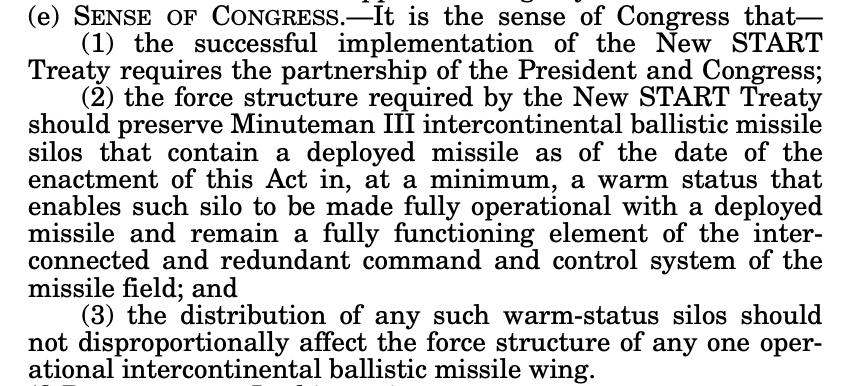
17 January 2014
Congress passes the FY 2014 Defense Appropriations Act.
The bill included language inserted by members of the Senate ICBM Coalition that explicitly blocked the Obama administration from conducting the environmental assessment that would be legally necessary to reduce the number of ICBM silos. In a subsequent statement, Coalition members specifically boasted about how they had overruled the Pentagon on the ICBM issue: “the Defense Department tried to find a way around the Hoeven-Tester language, but pressure from the coalition forced the department to back off.”
16 June 2014
Process of downgrading all Minuteman IIIs from three to one warhead completed.
In order to comply with New START, all remaining Minuteman III ICBMs were downgraded from three warheads to just one per missile.*
*John M. LaForge and Arianne S. Peterson, eds. Nuclear Heartland: Revised Edition (Luck, Wisconsin: The Progressive Foundation, Inc., 2015), p. 9.
July 2014
The Air Force completes its Analysis of Alternatives for the GBSD.
The Air Force’s AoA for the GBSD program recommended a complete replacement of the Minuteman III ICBM with The AoA offered four discrete reasons for its consequential recommendation, noting that a replacement would: address capability gaps and improve performance against current and expected threats; maintain the large solid rocket motor industrial base; share subcomponent commonality with the Navy’s ballistic missiles; and be cheaper than the cost of life-extending the Minuteman IIIs.* In hindsight, and upon further scrutiny, these assumptions appear to have either been flawed, exaggerated, or deprioritized.
*United States Air Force, “Cost Comparison of Extending the Life of the Minuteman III Intercontinental Ballistic Missile to Replacing it with a Ground-Based Strategic Deterrent: Report to Congress,” Department of Defense (July 2016), p. 4.
23 January 2015
The Air Force issues another Request For Information for the GBSD program.
In this RFI, the Air Force offered some additional public information about the proposed GBSD weapon system characteristics, specifically noting that they sought a replacement system that “replaces the entire flight system, retains the silo basing mode while recapitalizing the infrastructure, and implements a new Weapon System Command and Control (WSC2) system.”* Additionally, the RFI stated that the GBSD would utilize the existing Mk12A and Mk21 Reentry Vehicles, in addition to a brand-new missile stack and a potentially reduced number of launch control systems and launch facilities.
*Air Force Materiel Command Lifecycle Management Center, Hill Air Force Base, “Request for Information RFI #1, Ground Based Strategic Deterrent,” Contract Opportunity FA8219-15-R-GBSD-RFI1 (23 January 2015).
February 2015
The Air Force Nuclear Weapons Center completes its initial GBSD cost estimate.
The cost estimate of $62.3 billion (in Then-Year dollars) for 642 missiles over a 30-year period was eventually disclosed to the public on 5 June 2015. The total amount includes $48.5 billion for the missiles themselves, $6.9 billion for command and control systems, and $6.9 billion to renovate and upgrade the launch control centers and launch facilities.
November 2015
The Pentagon’s Office of Cost Assessment and Program Evaluation completes its review of the GBSD Program.
The Office of Cost Assessment and Program Evaluation (CAPE), the Pentagon’s independent budgetary and cost estimation assessment team, estimated that the GBSD would cost between $85 billion and $100 billion (in Then-Year dollars) – a discrepancy more than one-third higher than the Air Force’s original estimate. The Pentagon ultimately selected the lower $85 billion number for the GBSD program.
25 November 2015
Congress passes the FY 2016 National Defense Authorization Act.
The bill specifically prohibited the Pentagon from further reducing the alert level of the ICBM force, with the exception of changes “that are carried out in compliance with the New START treaty.”
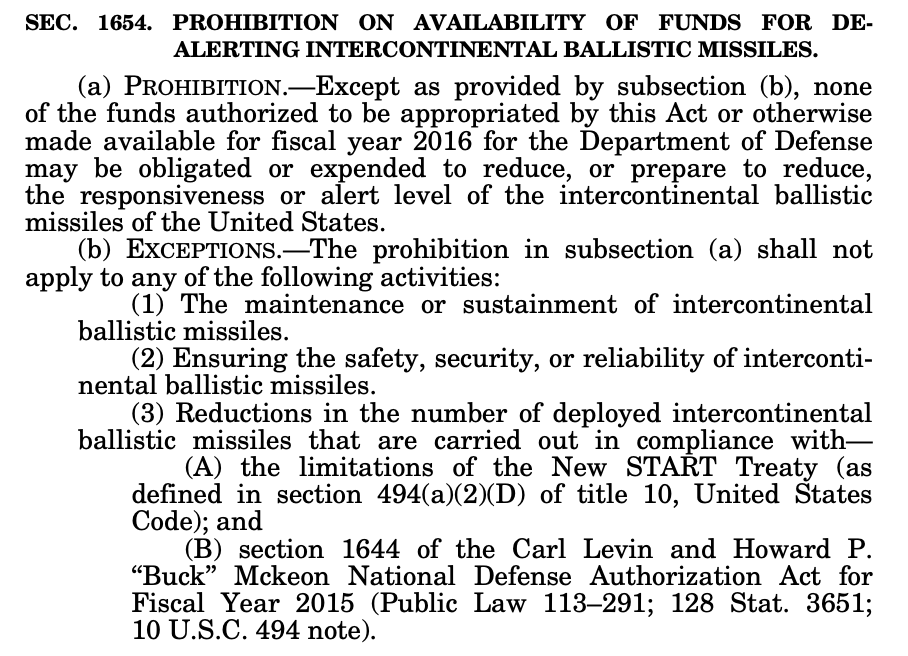
8 July 2016
Senate ICBM Coalition sends a letter to Secretary of Defense Ash Carter about GBSD.
The letter asked Carter to recommit to pursuing the GBSD program “as expeditiously as possible,” in light of concerns “that the Administration now may consider steps to slow down modernization programs or withdraw them from future year defense plans.”
29 July 2016
The Air Force Nuclear Weapons Center releases its Request For Proposals for the GBSD Technology Maturation and Risk Reduction contract.
The Technology Maturation and Risk Reduction phase of a defense acquisition program seeks to reduce technology and list-cycle cost risks, and further refine the requirements of the proposed system. In the RFP, the Air Force noted its intention to award up to two contracts for the TMRR phase of the GBSD program, which was scheduled to last approximately 36 months.
23 August 2016
Under Secretary of Defense for Acquisition, Technology, and Logistics approves the Milestone A decision for the GBSD program.
With the Under Secretary’s decision, the GBSD program formally entered the Technology Maturation and Risk Reduction phase of the acquisition process.* The Acquisition Decision Memorandum that was produced in conjunction with the decision accepted CAPE’s higher estimate of $85 billion for the production of 666 missiles and associated infrastructure costs.
*Now called the Under Secretary of Defense for Acquisition and Sustainment.
12 October 2016
Deadline for Technology Maturation and Risk Reduction proposals.
The Air Force received three submissions: Boeing, Northrop Grumman, and Lockheed Martin.
December 2016
Senate ICBM Coalition publishes a white paper: “The Enduring Value of America’s ICBMs.”
The paper argued that “The administration and Congress should reject any proposal to delay GBSD or extend the life of Minuteman III beyond the currently-planned 2030 timeframe.”
23 December 2016
Congress passes the FY 2017 National Defense Authorization Act.
The bill included a prohibition on reducing the alert level and quantity of deployed ICBMs below 400––a provision that has since been included in every subsequent NDAA to date.
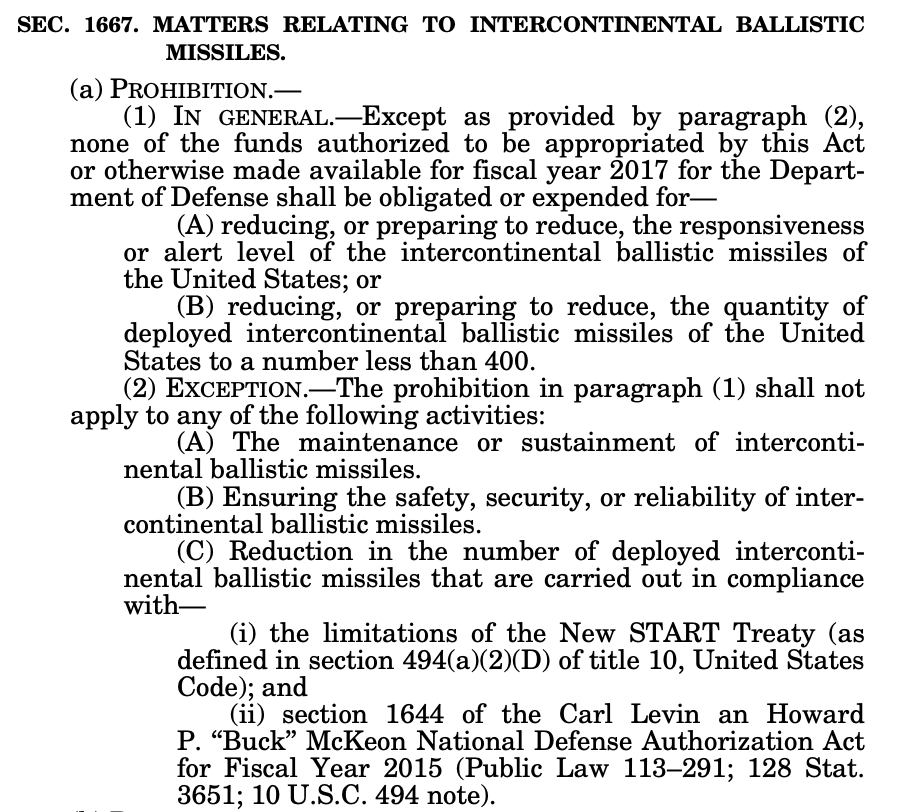
2 June 2017
Process of removing 50 Minuteman IIIs from their silos is completed.
In order to comply with New START’s central limits, 50 Minuteman III ICBMs were removed from their silos. As Congress had previously mandated, these silos were kept “warm.”
21 August 2017
The Air Force awards TMRR contracts to Boeing and Northrop Grumman.
The Air Force awarded two 36-month contracts for the TMRR phase of the GBSD program – one to Boeing for $349.2 million (FA8219-17-C-0001) and one to Northrop Grumman for $328.6 million (FA8219-17-C-0002). Nine days later, Lockheed Martin announced its intention not to protest its exclusion from the competition.
17 September 2017
Northrop Grumman agrees to terms of purchase with Orbital ATK for approximately $7.8 billion.
Over the past several decades, corporate consolidation in the defense industry had dramatically reduced the number of large solid rocket motor producers in the United States. In 1990 there were five, by 2017 there were only two remaining––Orbital ATK and Aerojet Rocketdyne. To that end, Northrop Grumman’s acquisition of Orbital ATK offered it a serious bidding advantage over Boeing––its only competitor for the GBSD program.
October 2017
The Congressional Budget Office estimates the cost of US nuclear modernization to be $1.2 trillion.
The CBO estimated that if the United States delayed GBSD for two decades, then approximately $42 billion (in 2017 dollars) of the costs of replacing the Minuteman IIIs would be pushed beyond 2046. This would allow the total costs of nuclear modernization to be spread out over several decades and alleviate significant budgetary pressures over the coming years. If GBSD was ultimately cancelled, the CBO estimated that this would save $120 billion (in 2017 dollars).
12 December 2017
Congress passes the FY 2018 National Defense Authorization Act.
The bill prevented the Air Force from awarding an engineering and manufacturing development contract for the GBSD that would reduce the number of fixed launch control centers below current levels, unless the Commander of STRATCOM overruled it. This provision, however, was not included in subsequent NDAAs and appears to have been overridden, as the Air Force’s recent Environmental Impact Statement announcement appears to indicate a significant reduction in each missile wing’s launch control centers––from the current 15 to an eventual eight per wing.
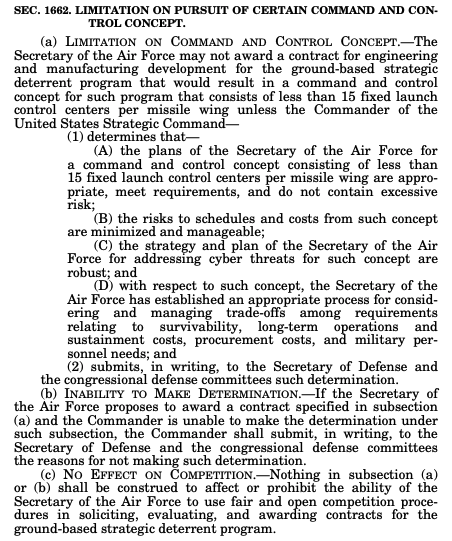
5 February 2018
Both the United States and Russia reach compliance with New START’s central limits.
By this time the United States and Russia were required to meet the Treaty’s central limits of 800 deployed and non-deployed land-based intercontinental ballistic missile (ICBM) and submarine-launched ballistic missile (SLBM) launchers and deployed and non-deployed nuclear-capable heavy bombers; 700 deployed ICBMs, deployed SLBMs, and deployed nuclear-capable heavy bombers; and 1,550 deployed warheads.
March 2018
The Air Force Nuclear Weapons Center drafts a memo seeking “Justification and Approval (J&A) for Other Than Full and Open Competition” for the GBSD program.
Since “full and open competition” for contracts is required by law, an awarding agency must submit a “Justification and Approval” (J&A) request in order to circumvent this procedure. The Air Force Nuclear Weapons Center’s J&A request suggested that limiting the solicitation of the GBSD’s Engineering and Manufacturing Development (EMD) contract to just two bidders––Boeing and Northrop Grumman––would be acceptable because “typically, expected cost savings from a competition come from a competition premium––the cost savings which come from competing a contract rather than soliciting a single supplier. In this case, the [Air Force] expects to obtain a competition premium despite the exclusion of sources, because the selection will be a competition between the two TMRR offerors [sic].”* Given that the EMD contract was ultimately sole-sourced to Northrop Grumman in September 2020, these expected cost savings are unlikely to be realized. The J&A request was ultimately approved by Assistant Secretary of the Air Force William B. Roper, Jr. on 26 February 2019.
*“Justification and Approval (J&A) for Other Than Full and Open Competition,” GBSD program document approved by William B. Roper, Jr., Assistant Secretary of the Air Force (Acquisition, Technology & Logistics), 26 February 2019.
June 2018
Northrop Grumman acquires Orbital ATK for $7.8 billion.
The Federal Trade Commission investigated the merger over concerns that it could “substantially lessen competition and […] create a monopoly in the relevant market for missile systems.” Specifically, the FTC expressed concerns that “If Northrop were to foreclose its missile system prime contractor competitors in any of these ways, the United States Government would be harmed because cost of missile systems may increase, innovation may be lessened, and/or quality would be reduced because the United States Government would be less likely to obtain the best possible combination of missile system prime contractor and SRM supplier.” The FTC ultimately did not block the acquisition; however, it ruled that Northrop Grumman was required to “not Discriminate in any Missile Competition where Northrop is currently competing to be the Prime Contractor.” Specifically, Northrop Grumman would have to make its solid rocket motor products and services fully available to Boeing and would not be permitted to share Boeing’s proprietary data with other parts of the Northrop Grumman corporation to gain leverage over its competitor in other projects.
March 2019
The Air Force’s Deputy Chief of Staff for Strategic Deterrence and Nuclear Integration testifies to Congress that it would be technologically feasible to life-extend the Minuteman III one more time.
When asked about extending the service life of the Minuteman III, Lieutenant General Richard Clark testified, “The propulsion system, the guidance system, even the ability to provide the solid rocket motor fuel, we only have one more opportunity to do that for these weapons.”
18 June 2019
The GBSD Capability Development Document is validated.
The Capability Development Document specifies the operational requirements for the system that is being developed.*
*Department of the Air Force, “Report on Development of Ground-Based Strategic Deterrent Weapon,” Report to Congressional Committees (May 2020), p. 3.
3 July 2019
Northrop Grumman reportedly signs FTC-mandated firewall agreement for the GBSD program.
This agreement was reportedly signed over a year after the FTC’s ruling, and only five months away from the RFP submission deadline for the GBSD EMD contract. According to Boeing CEO Leanne Caret, this delay did not leave Boeing enough time to negotiate a competitive price for solid rocket motors.
11 July 2019
House amendment in FY 2020 NDAA for ICBM study is voted down.
The Senate ICBM Coalition’s allies in the House of Representatives helped quash an amendment to the FY 2020 NDAA that calls for an independent study on a life-extension program for the Minuteman III.
16 July 2019
The Air Force releases its RFP for the Engineering and Manufacturing Development phase of the GBSD program.
The request for proposals process lasted just over a year before the eventual award of the EMD contract to Northrop Grumman in September 2020.
25 July 2019
Boeing announces its withdrawal from the GBSD competition.
In a series of letters addressed to Air Force acquisition executive Will Roper, Boeing Defense and Security CEO Leanne Caret wrote, “We lack confidence in the fairness of any procurement that does not correct this basic imbalance between competitors,” explicitly citing Northrop Grumman’s acquisition of Orbital ATK as evidence that there were “inherently unfair cost, resource and integration advantages” at play.
September 2019
Boeing lobbies both Congress and the Air Force, with the goal of forcing Northrop Grumman into a joint GBSD bid.
Boeing announced that it is actively seeking “government intervention” that would require Northrop Grumman to either add Boeing to its GBSD team as a major subcontractor, or perhaps as a co-equal partner. This effort was ultimately unsuccessful, despite the public support from allies like Senator Doug Jones (D-AL).
3 September 2019
Northrop Grumman formally declines Boeing’s request to form a “best-of-industry GBSD team.”
Boeing officials claimed that a Northrop Grumman-Boeing partnership would produce the GBSD “sooner, and with lower risk than either of us could do alone.” Northrop Grumman declined the offer.
16 September 2019
Northrop Grumman unveils its GBSD team.
Northrop Grumman’s team announcement included the following contractors:
- Aerojet Rocketdyne: solid-fueled rocket motors, post-boost propulsion
- General Dynamics: command and control
- Collins Aerospace: command and control
- Lockheed Martin: command and control, missile payload integration
- Textron System: missile payload integration
- Parsons: engineering, procurement, construction
- BRPH: architectural and engineering
- Clark Construction: construction integration
- L3Harris: training systems
- Honeywell: guidance, missile electronics
The inclusion of Aerojet Rocketdyne is notable, given Northrop Grumman’s prior acquisition of Orbital ATK. However, it remains unclear how much of the overall large solid rocket motor order will be filled by Aerojet and how much will be filled by Orbital, which has since been renamed “Northrop Grumman Innovation Systems.”
25 September 2019
Senate ICBM Coalition sends a letter to Secretary of Defense Mark Esper.
The letter noted the Coalition’s concerns over “recent calls to modify the GBSD acquisition strategy,” and urged Esper to “ensure the GBSD program is not disrupted or delayed.”
October 2019
The Air Force functionally cancels the remainder of Boeing’s TMRR contract for the GBSD.
Given Boeing’s stated intention to not bid for the EMD contract in December 2019, the Air Force refused to allocate any further funding to Boeing’s TMRR contract. This prompted Boeing to immediately issue a Stop Work notice for all GBSD work, stating that “We believe this work would provide substantial value to the Government, irrespective of the fact that Boeing will not participate as a prime offeror under the current EMD [engineering, manufacturing and development] solicitation structure for the next phase of the GBSD program.”
13 December 2019
The RFP deadline for the GBSD’s Engineering and Manufacturing Development contract passes, with the Air Force only receiving a single bid––that of Northrop Grumman.
Northrop Grumman became the default winner of the EMD contract after Boeing declined to bid on the program.
1 July 2020
The House Armed Services Committee rejects an amendment to transfer $1 billion from the GBSD towards Covid-19 relief.
In a bipartisan vote of 44-12, the HASC voted down an effort to transfer GBSD funding to pandemic preparedness, with Committee member Liz Cheney (R-WY) claiming that such an amendment would “help America’s adversaries.”
22 August 2020
CAPE raises its GBSD cost estimate, projecting a new total acquisition cost of $95.8 billion.
This constitutes a near-10 percent increase from the $85 billion figure adopted by the Pentagon in 2016. The cost breakdown is listed as follows: $25.5 billion for research and development, $61.6 billion for missile procurement, and $8.7 billion for military construction, plus an additional $166.6 billion for long-term support costs and $1.4 billion for disposal. CAPE’s projection for the GBSD’s total life-cycle cost is set at $263.9 billion (in Then-Year dollars) through 2075. This new estimate was provided to Congress in September.*
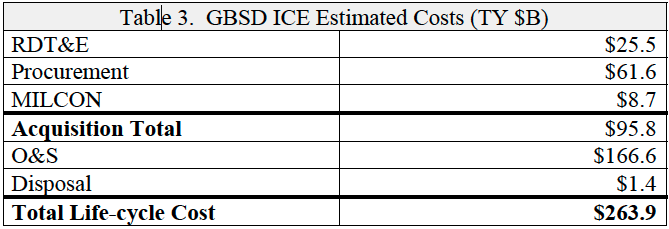
*Under Secretary of Defense for Acquisition and Sustainment, “(U) Ground Based Strategic Deterrent Milestone B Summary: Report to Congress,” Department of Defense (September 2020), p. 5, retrieved through FOIA 21-F-0065 on 24 November 2020.
4 September 2020
Under Secretary of Defense for Acquisition and Sustainment approves the Milestone B decision for the GBSD program.
A Milestone B approval is necessary in order to award an Engineering and Manufacturing Development contract.*
*Previously called the Under Secretary of Defense for Acquisition, Technology, and Logistics.
8 September 2020
The Air Force awards the $13.3 Engineering and Manufacturing Development contract for the GBSD to Northrop Grumman.
The EMD contract is expected to run through February of 2029, and the contract includes weapon system design, qualification, test and evaluation, and nuclear certification.
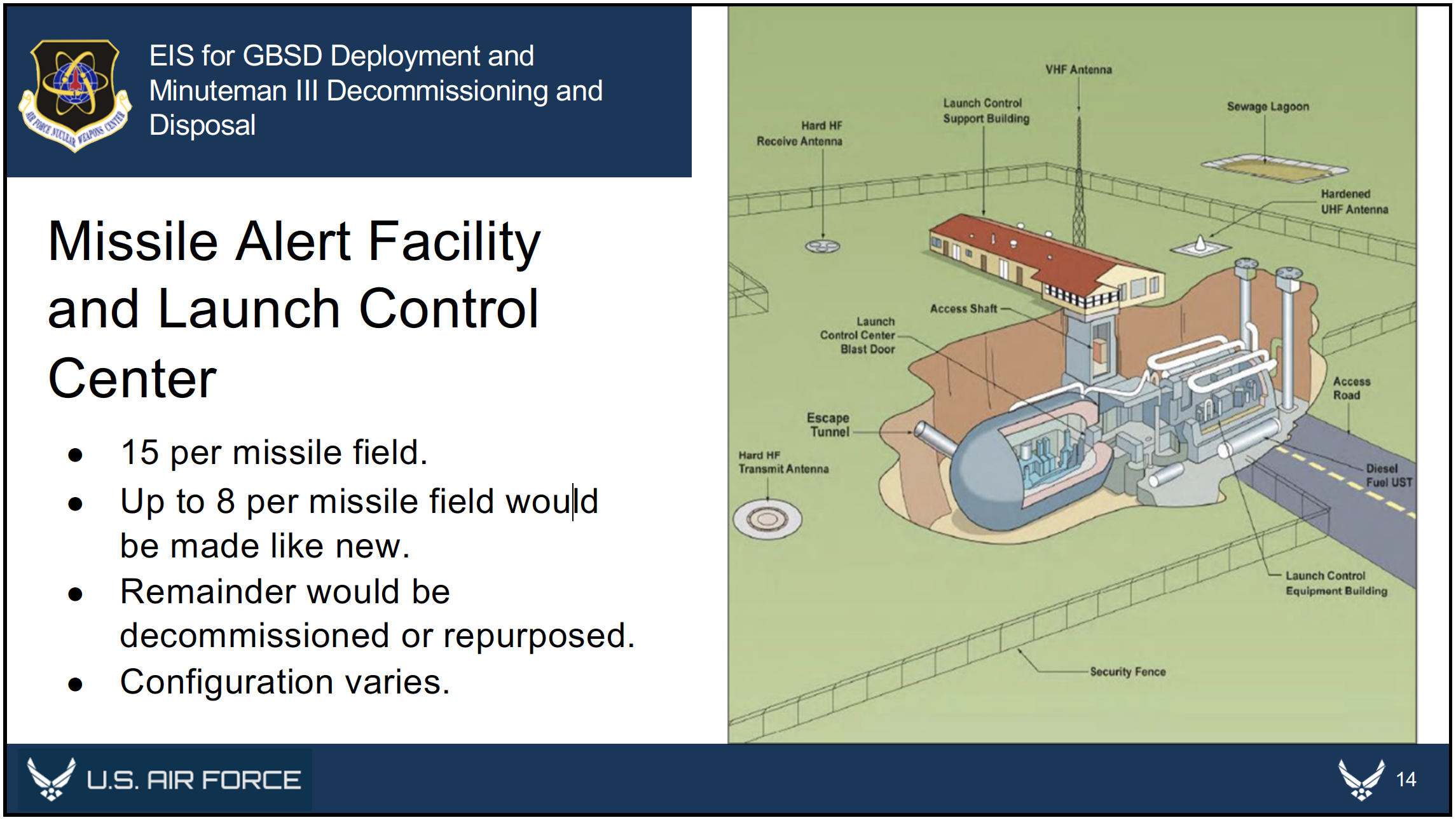
25 September 2020
The Air Force issues a Notice of Intent to prepare an Environmental Impact Statement (EIS) for the GBSD.
The Air Force’s GBSD EIS website reveals that the number of launch control centers at each missile wing will be reduced by nearly half, and that substantial GBSD-related construction is expected to take place at all three ICBM bases, in addition to Hill Air Force Base and the Utah Test and Training Range.
Spring 2022
The Draft Environmental Impact Statement for the GBSD is scheduled to be released, and will be available for public comment.
Click here to read the schedule.
2023
Construction and deployment is scheduled to begin at F.E. Warren Air Force Base, and is expected to be completed by 2031.
Spring 2023
The Final Environmental Impact Statement for the GBSD is scheduled to be released.
2025
Construction and deployment is scheduled to begin at Malmstrom Air Force Base, and is expected to be completed by 2033.
2026
The NNSA is scheduled to produce up to 30 plutonium pits per year by 2026.
These pits will ultimately be used to produce the W87-1 warhead, which will be used for the GBSD. Given that the United States has not had the capability to produce more than 10 plutonium pits per year for over two decades, it is widely expected that this ambitious schedule will be delayed.

2027
Construction and deployment is scheduled to begin at Minot Air Force Base, and is expected to be completed by 2036.
April-June 2029
The Air Force projects the GBSD to reach Initial Operational Capability.
In order to reach IOC, the GBSD program must complete the Minuteman III-to-GBSD transition for 20 Launch Facilities––each loaded with an in-silo missile and deployed with a Mk21/W87-1 warhead––three Launch Control Centers, and one Integrated Command Center at the same missile wing as the three Launch Control Centers (likely to be F.E. Warren).*
*Department of the Air Force, “Report on Development of Ground-Based Strategic Deterrent Weapon,” Report to Congressional Committees (May 2020).
2030
The NNSA is scheduled to produce up to 80 plutonium pits per year by 2030.
According to the Government Accountability Office, “it is not clear that NNSA will be able to produce sufficient numbers of pits—the fissile cores of the primary—to meet the W87-1 warhead’s planned production schedule.”

2036
The Air Force projects the GBSD to reach Full Operational Capability.
In order to reach IOC, the GBSD program must complete the Minuteman III-to-GBSD transition for all 450 Launch Facilities, at least 24 Launch Control Centers (eight per wing), three Integrated Command Centers, and command and control infrastructure for all three missile wings.*
*Department of the Air Force, “Report on Development of Ground-Based Strategic Deterrent Weapon,” Report to Congressional Committees (May 2020).
British Defense Review Ends Nuclear Reductions Era
[Article updated May 11, 2021] The United Kingdom announced yesterday that it has decided to abandon a previous plan to reduce it nuclear weapons stockpile to 180 by the mid-2020s and instead “move to an overall nuclear weapon stockpile of no more than 260 warheads.”
The decision makes Britain the first Western nuclear-armed state to increase its nuclear weapons stockpile since the end of the end of the Cold War. In terms of numbers, it takes Britain back to a stockpile size it had in the early-2000s. The change is part of “a shift to a more robust position on security and deterrence.”
The Review also decided that Britain will “no longer give public figures for our operational stockpile, deployed warhead or deployed missile numbers.” This counterproductive decision follows the earlier decision of the Trump administration to keep the nuclear stockpile number secret. By embracing nuclear secrecy, Britain effectively abdicates its ability to criticize Chinese or Russian secrecy about their nuclear arsenals.
The decision to increase the size of the future stockpile – and potentially deploy more warheads on British submarines – is but the latest example of nuclear-armed states invigorating a nuclear arms race and reversing progress toward reducing the world’s nuclear arsenals.
The British Nuclear Weapons Stockpile
The British government has never declassified the history of its nuclear weapons stockpile. Instead, it has occasionally published documents or made statements that gave overall numbers or percentages. The government announced in 2010 that it would have “no more than 225” warheads and later that the limit would be reduced to 180 by the mid-2020s. It is unknown how far the reduction of those approximately 45 warheads has progressed. If spread out evenly over the 15 years, the number might have reached just below 200 by now. But it is highly uncertain so illustrating the British stockpile comes with considerable uncertainty (In this article we conclude that the stockpile did not drop below the 225 ceiling set in 2010 and remains at that level today). The following graph is illustrative and based on previous statements and documents.

Note: This graph has been updated. The history of the United Kingdom nuclear weapons stockpile is still classified, so the graph is provided for illustrative purposes. Click on graph to view full size.
The timeline for the new stockpile limit of 260 warheads is not entirely clear but appears to be during the 2020s. The Review reflects an assessment out to 2030 but “establishes the Government’s overarching national security and international policy objectives, with priority actions, to 2025.”
The wording of the new warhead level is vague. The Review sets the number at “no more than 260 warheads.” The British government has subsequently explained the “260 figure is a ceiling, not a target.” Political damage control is probably part of that statement, but the number could potentially be somewhat lower – or it could be about 260.
Not all of the stockpiled warheads are deployed. The majority is called “operationally available,” which means they’re onboard three of the four SSBNs or can be loaded fairly quickly. The rest are a reserve as spares or undergoing maintenance. Since 2015, the number of “operationally available warheads” has been approximately 120, of which the number deployed on the single SSBN at sea has been reduced to 40.
Unlikely previous defense reviews, the Integrated Review does not include any information about how many of the stockpiled warheads will be operationally available, loaded onboard deployed submarines, or how many submarines will be at sea at any given time. This is a step back for British nuclear transparency. Based on statements from previous governments, however, the number of operationally available warheads under the Johnson posture might end up being similar to what it was during the Blair government: perhaps close to 160 warheads.
The stockpiled warheads that are not “operationally available” are likely stored at Coulport Ammunition Depot nearly the Faslane Submarine Base in Scotland (see image below). Warheads undergoing maintenance or upgrade to the Mk4A aeroshell are probably stored at AWE Burghfield or AWE Aldermaston west of London. Retired warheads are shipped to Burghfield for dismantlement and disposition.
In 2013, the UK government described the process: warheads “yet to be disassembled” are stored at Coulport or as “work in progress” at Burghfield. “A number of warheads identified in the [stockpile reduction] programme for reduction have been modified to render them unusable whilst others identified as no longer being required for service are currently stored and have not yet been disabled or modified.”
Those retired warheads that have not been “rendered unusable” are most likely the source for increasing the stockpile now. Britain doesn’t have the capacity to quickly produce 50-60 new warheads so it simply brings warheads out of retirement. Reconstituting those warheads can probably be done in a few years.
Nuclear Strategy and Targeting
The extent to which the increased stockpile will affect targeting requirement for Britain’s ballistic missile submarines remains to be seen. But the Review states that the stockpile increase comes in response to “the evolving security environment, including the developing range of technological and doctrinal threats.”
Russia is singled out as “the most acute direct threat to the UK” but the Review also contains what appears to be a subtle but clear nuclear threat against Iran (even though it doesn’t have nuclear weapons). After assuring the “UK will not use, or threaten to use, nuclear weapons against any non-nuclear weapon state party to the Treaty on the Non-Proliferation of Nuclear Weapons 1968 (NPT),” the Review adds: “This assurance does not apply to any state in material breach of those non-proliferation obligations.”
The difference between the stockpile limit number and operationally deployed warheads in previous government statements indicates that an increased stockpile limit of 260 warheads most likely will also result in an increase in the number of operationally available warheads and possibly the number of warheads onboard the submarines. An increased number of deployed warheads means an increased number of aimpoints. The United States shares strategic war plan details with the United Kingdom in support of NATO.
In 1998, there were fewer than 200 operationally available warheads. In 2007, that category was reduced to 160 warheads, of which 48 were onboard the submarine at sea. In 2015, that category was reduced to 120 warheads, of which 40 were onboard the single submarine on patrol. The Review states that “at least one [submarine] will always be on a Continuous At Sea Deterrent patrol” (CASD) “at several days’ notice to fire…to guarantee that the UK’s nuclear deterrent remains credible and effective against the full range of state nuclear threats from any direction.”
Perhaps the increased stockpile is intended to facilitate increased targeting of Russia. Perhaps it broadens targeting to other potential adversaries (China, Iran). Perhaps it increases targeting of non-nuclear strategic threats. Perhaps it’s a combination.
The US Connection
The British announcement to increase its stockpile is particularly sensitive now because it preempts the new Biden administration’s upcoming nuclear posture review. Given the nuclear developments in Russia and China, it already seemed unlikely that Biden would reduce the US stockpile further than previously planned. But nuclear proponents in the United States must be rejoicing; the British announcement makes it politically awkward for the Biden administration to reduce.
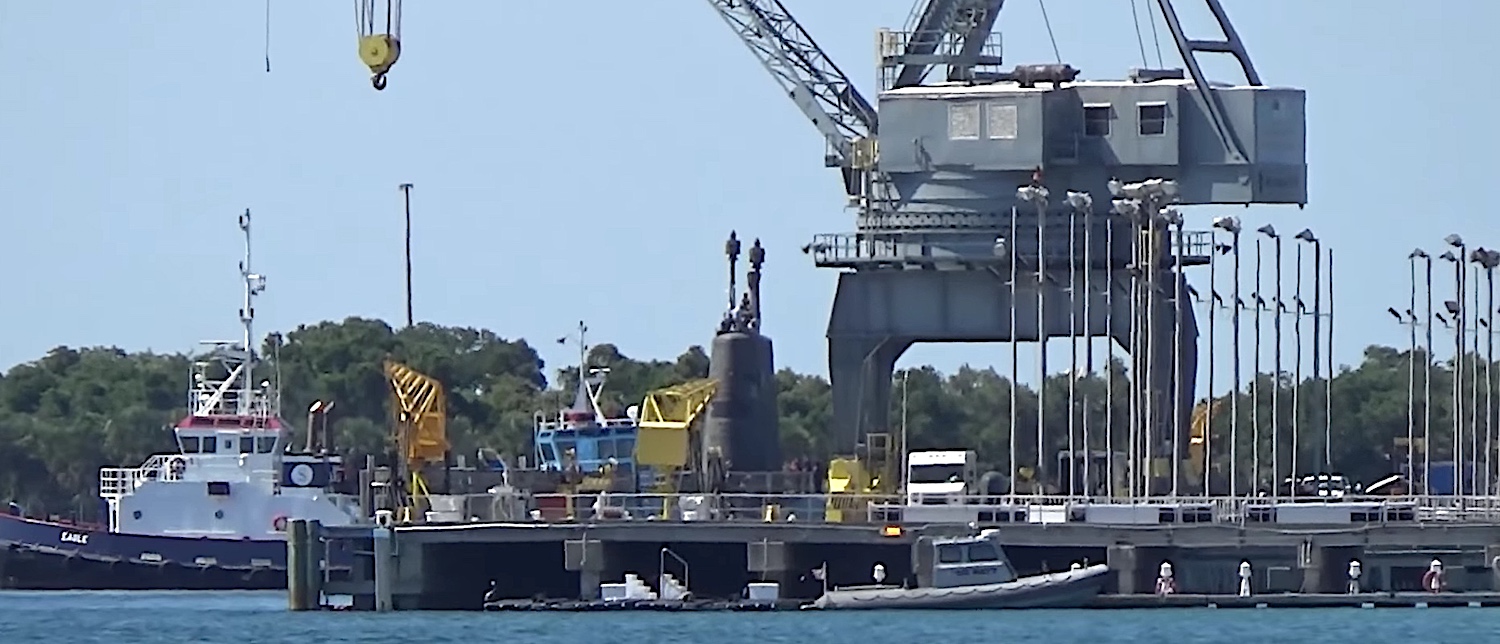
Britain does not own its own ballistic missiles but leases U.S. Trident II D5 missiles. British SSBNs conduct test flights off Florida after being serviced at Port Canaveral.
The current British warhead, known as the Holbrook, is thought to closely resemble the U.S. W76-0. The British warhead is so similar that it is part of the U.S. Department of Energy’s “W76 Needs” maintenance schedule. The Holbrook warhead is currently being backfitted with the new Mk4A aeroshell with enhanced targeting capability. Increasing the stockpile presumably will require buying additional Mk4A aeroshells from the United States.
But the Holbrook is getting old, so British officials have been busy lobbying the U.S. government about moving forward with its proposed new W93/Mk7 warhead, which will also form part of Britain’s next warhead design. Although a U.S. defense official has described the two programs as “two independent, development systems,” a British defense official subsequently explained that although they are “not exactly the same warhead…there is a very close connection in design terms and production terms.” Like the Holbrook, which is contained in the U.S. produced Mk4A reentry body, the new British warhead will be contained in the U.S. produced Mk7 reentry body.
It sounds like we can look forward to another 30 years of discussion about how independent the British deterrent is.
The NPT Context
The decision to increase the nuclear weapons stockpile strongly conflicts with the role Britain has played in nuclear disarmament efforts and the nuclear Nonproliferation Treaty (NPT) regime over the past three decades. All those efforts have been about reducing arsenals. The Review breaks with that legacy.
Nonetheless, the Review reiterates long-held British support for the NPT: “We remain committed to the long-term goal of a world without nuclear weapons. We continue to work for the preservation and strengthening of effective arms control, disarmament and non-proliferation measures, taking into account the prevailing security environment. We are strongly committed to full implementation of the NPT in all its aspects, including nuclear disarmament…” In fact, the commitment to NPT as an instrument for disarmament is so singular that the Review states that “there is no credible alternative route to nuclear disarmament.”
Although NPT’s Article VI does not explicitly prohibit Britain from increasing its nuclear stockpile, it obligates Britain to “pursue negotiations in good faith on effective measures relating to cessation of the nuclear arms race at an early date and to nuclear disarmament, and on a treaty on general and complete disarmament under strict and effective international control.”
Increasing the stockpile in response to Russia and other threats certainly seems to conflict with the goal of ending the nuclear arms race. Instead, it seems to embrace a race.
Moreover, British governments have explicitly linked stockpile reductions to its “obligations under Article six.” In 2015, for example, the U.K. delegation to the NPT Review Conference stated that the “United Kingdom remains firmly committed to step-by-step disarmament, and our obligations under Article Six. We announced in January that we have reduced the number of warheads on each of our deployed ballistic missile submarines from 48 to 40, and the number of operational missiles on each of those submarines to no more than eight.”
The decision to increase the stockpile clearly contradicts those assurances and obligations. That, and the decision to reduce nuclear transparency, will make it less credible for British diplomats to criticize Russia and China for increasing their stockpiles and hiding behind nuclear secrecy. It might also weaken Britain’s ability to appeal to Iran not to develop nuclear weapons.
In conclusion: Johnson has pulled a Trumpie that will boost Britains nuclear profile but do little to reduce nuclear dangers.
Additional information: United Kingdom Nuclear Weapons, 2021
This publication was made possible by generous support from the John D. and Catherine T. MacArthur Foundation, the New Land Foundation, the Ploughshares Fund, and the Prospect Hill Foundation. The statements made and views expressed are solely the responsibility of the author.
Siloed Thinking: A Closer Look at the Ground-Based Strategic Deterrent
“Siloed Thinking,” authored by Research Associate Matt Korda, reviews the fundamental role of intercontinental ballistic missiles (ICBMs) in US nuclear strategy and examines the Pentagon’s justifications for pursuing an ICBM replacement program.
The report ultimately suggests that these justifications were based on flawed assumptions, and many have since been deprioritized. The report also suggests that the initial outcome favoring a brand-new ICBM replacement program was largely predetermined by arbitrary force requirements and timelines that have little 21st century strategic rationale.
These conclusions suggest that the Pentagon’s case for the ICBM replacement program, known as the Ground-Based Strategic Deterrent (GBSD) needs to be reevaluated in light of cost escalation and surrounding budgetary pressures.
Download the report here.
FAS Presses for Release of Nuclear Stockpile Data
Updated below
For the past three years, the Trump Administration refused to provide an annual tally of the number of nuclear weapons in the U.S. nuclear stockpile or the number of weapons that had been dismantled each year, though that had been the practice under the Obama Administration and through 2017.
The Federation of American Scientists asked the Biden Administration to restore the prior level of disclosure and to report the missing stockpile and dismantlement numbers for 2018, 2019 and 2020.
In a petition submitted to the Department of Energy, FAS noted that President Biden had directed agencies in a February 4 directive to adopt “the highest standards of transparency.”
“By terminating the annual disclosure of stockpile information, the prior Administration retreated from ‘the highest standards of transparency’ that previously prevailed,” the FAS petition said.
The Department of Energy acknowledged receipt of the request. Declassification and disclosure of the requested stockpile data will require concurrence of both DOE and DoD. Historically, DOE has long been willing to disclose such information, while DoD has often resisted release.
* * *
According to FAS estimates by Hans M. Kristensen and Matt Korda, the current U.S. nuclear stockpile is around 3,800 weapons, and the number of weapons dismantled is probably around 300-350 per year. For more detail, see the FAS Nuclear Notebook on United States nuclear weapons, 2021, published by the Bulletin of the Atomic Scientists.
Although the unofficial estimates are probably quite accurate, formal declassification remains desirable both in order to curtail improper secrecy and to enable government officials to freely address the subject in open public forums.
Update (October 5, 2021): The Department of State and the National Nuclear Security Administration have now released annual stockpile and dismantlement figures through FY 2020.
Aging Electronics May Limit Nuke Reliability
The use of commercial off-the-shelf (COTS) electronic parts in nuclear weapons systems may reduce the reliability of the US nuclear arsenal over time as the electronics age in ways that are hard to predict, according to a newly disclosed report from the JASON science advisory panel.
“Most of the electronic materials and components within a weapon system are electrically inactive for a majority of the system lifetime” — which in a nuclear weapon can last for decades. “Determining the reliability of successfully executing a highly demanding, short-duration, operational sequence for systems that have been dormant over extended time periods challenges our ability to model, predict, and meet system performance requirements,” the JASON report to the National Nuclear Security Administration said.
“A goal of reliable performance after 40-60 years of unmonitored storage poses difficult, and perhaps unrealistic, challenges for electronic components to electrical subsystems and systems, whether or not COTS materials are utilized.” See Electronic Materials Aging, JASON report JSR-20-2B, November 2020.
The JASON panel offered 15 recommendations for identifying and detecting electronic failure modes and validating electronic reliability under the long-term conditions of the US nuclear stockpile.
The characteristic failure modes of electronics that are dormant for decades differ from those that are in regular use. But the concern for reliability is of course not unique to nuclear weapons.
“The aeronautics, aerospace, automotive, and medical device industries face similar design and assembly challenges – to ensure reliable performance and extremely low failure rates in electronics built with commercial components, often for high-consequence applications,” the report noted.
Accordingly, the JASONs said, NNSA should partner with the Department of Defense, NASA and others to share relevant knowledge and to undertake a “forward-looking program of focused materials research and development. . . . This will remain important as long as consumer electronics continue to change rapidly; there is no one-and-done solution that will solve the challenges associated with materials aging and reliability of COTS electronic systems with long dormancy.”
In the meantime, NNSA should also pursue “component and subsystem designs that enable regular monitoring through subsystem testing done in the field, in order to ensure reliable functioning of the electronics components.”
The systematic adoption of COTS electronics within military programs was driven in part by a 1994 memo from Defense Secretary William Perry, “Specifications & Standards — A New Way of Doing Business,” which encouraged DoD to increase reliance on commercial technology.
In the past, electronic components were specifically designed and fabricated for each weapon system, the JASONs noted. “Traditionally, in weapons systems, custom parts were used and strong control was exerted over the part manufacturers; reliability still had to be assessed.”
But today, “The military remains only a small fraction of the electronics market and so cannot alone be expected to drive new products, enforce quality, or improve reliability.”
As a result, “NNSA should view with skepticism expectations of long-term stability and reliability when adopting COTS electronic components whose design and manufacture were predicated on applications in commercial products with limited service lifetimes,” the JASONs said.
The JASON report was released by NNSA on March 9 under the Freedom of Information Act with redactions of certain deliberative information “regarding the future of the Nuclear Weapons Program.”
China’s Expanding Missile Training Area: More Silos, Tunnels, and Support Facilities
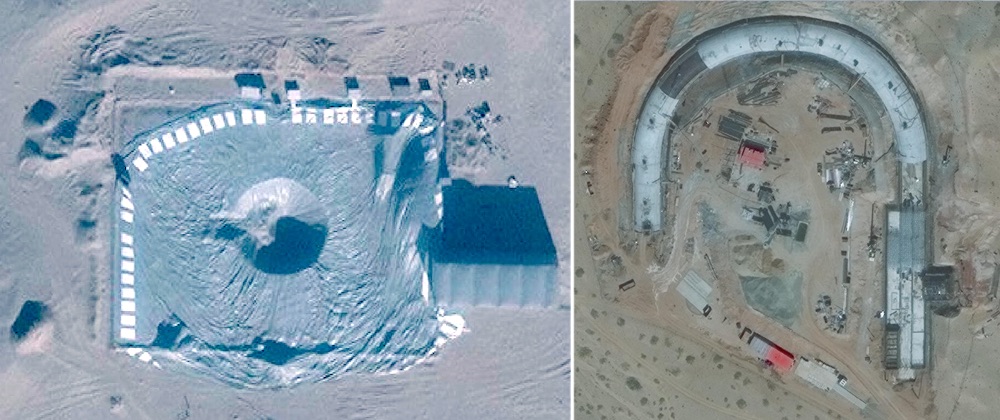
The Chinese military appears to be significantly expanding the number of ballistic missiles silos under construction in a new sprawling training area in the northern part of central China.
Recent satellite images indicate that at least 16 silos are under construction, a significant expansion in just a few years since a silo was first described in the area.
The satellite images also reveal unique tunnels potentially constructed to conceal missile launch units or loading operations.
The training area, located east of the city of Jilantai in the Inner Mongolia province, is used by the People’s Republic of China Rocket Force (PLARF) to train missile crews and fine-tune procedures for operating road-mobile missile launchers and their support vehicles.
The Jilantai PLARF Training Area
The Jilantai training area stretches for 140 kilometers (87 miles) over an area of nearly 2,090 square-kilometers (800 square miles) of desert and mountain ranges. It is a relatively new training area with most facilities added after 2013 and has since expanded to well over 140 missiles launch pads used by launch units to practice launch and loading procedures, more than two dozen campgrounds where launch units stay for a short period before moving on, five high-bay garages servicing launchers and support vehicles operating in the area, and a large supply base with adjacent support facilities (see image).
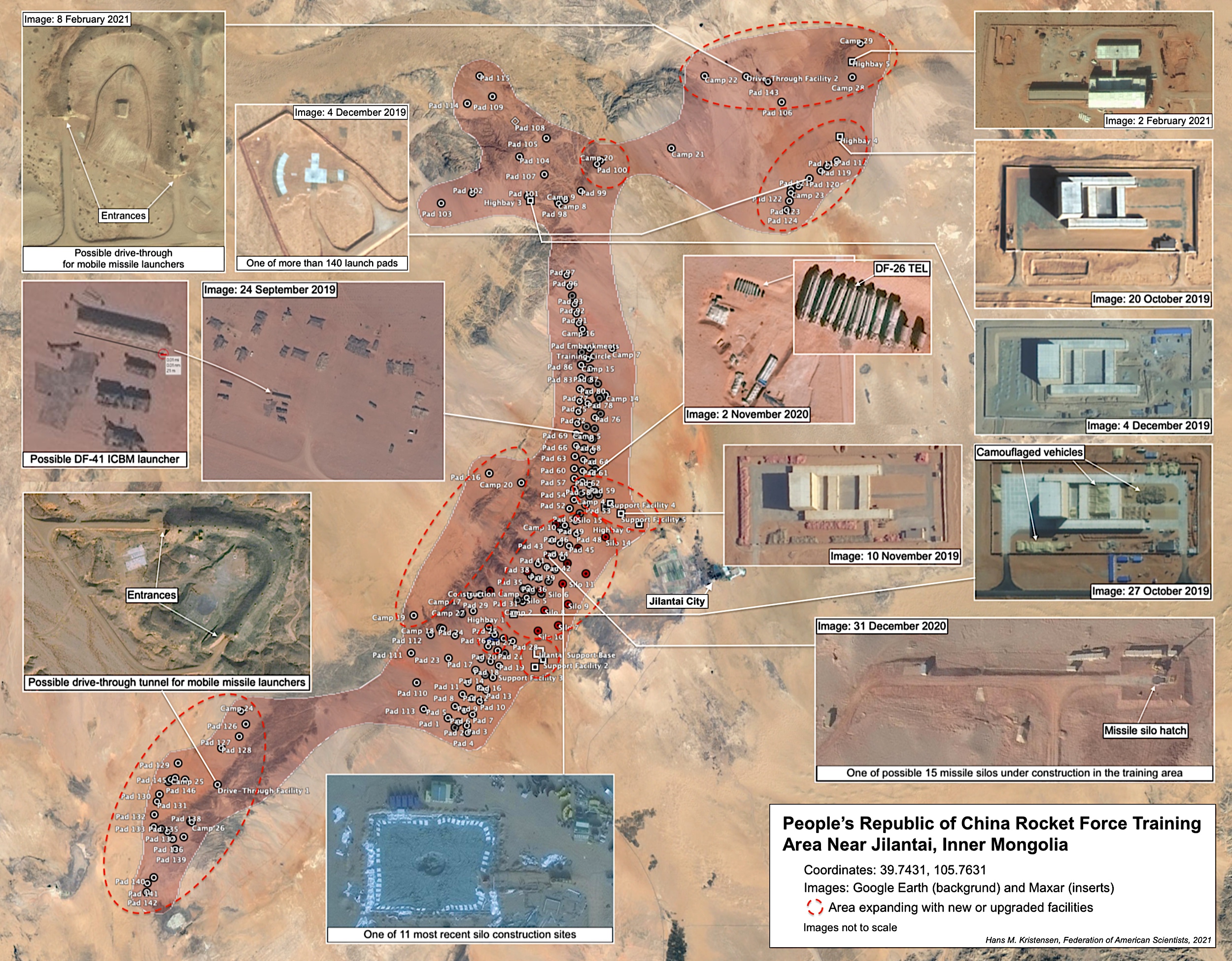
Click on image to view full size. To download an updated Google Earth placemark file with all facilities in the Jilantai training area, click here.
The training area is very active and is currently expanding in several regions, especially to the north and south as well as in the center. The expansion includes new high-bay facilities that handle launchers and missiles, a vast number of pads used by launchers and their support vehicles, missile silos, camping areas used by launch units, and underground facilities to hide and protect launchers.
Mapping the area took quite a lot of work spread out over the past two years. Unfortunately, Google Earth only has very limited and outdated image coverage of the area. Only the north-eastern sector has fairly recent images (2019). The vast majority of the imagery is still from 2013 and 2014. This is a surprise, given how much interest there is in this area. Instead, thanks to funding support from my funders listed at the bottom of this article, I used a subscription to Maxar’s Secure Watch service to get access to updated high-resolution imagery. The service is too expensive to use to search large areas and Planet Labs has a hefty price to even get access to low-resolution imagery. Fortunately, the European Sentinel Hub Playground offers free low-resolution imagery that served as a useful tool to detect new structures (the imagery is updated every five days) that could then be examined more closely with Maxar images.
Monitoring this area provides a wealth of information about how PLARF operates its mobile missiles units, the vehicles that are involved in the operations, and what structures and features to look for in the actual base deployment areas throughout China. It also provides important clues about China’s current and future nuclear modernization and helps assessing claims made by US defense officials about China’s capabilities.
Silo Construction
One of the most important new developments in the Jilantai training area is the construction of a significant number of facilities that appear to be silos intended for ballistic missiles. In the future we might see missile test launches from these silos.
Nearly all of the silos appear to be smaller than the type used for the large DF-5 ICBM in the base areas. The Department of Defense says that Jilantai “is probably being used to at least develop a concept of operations for silo basing” the DF-41.
At least 16 silos appear to be under construction (see image below). They vary in dimensions and construction has so far happened in three phases: the first silo facility started construction in 2016, four “Russia-type” silos followed in 2018-2020, and construction of an additional 11 silos began in late-2020. All of the silos are located in the center of the training area within a 10×20-kilometer (12×7-mile) area. The silos are spaced 2.2-4.4 kilometers (1.4-2.7 miles) apart, enough to ensure, presumably, that no two of them can be destroyed in a single one nuclear attack.
The first silo began construction in 2016 with what appears to include a silo and several underground facilities (39.7000, 105.4164). The outline and features are similar, but not the same, as the new silo constructed at the Wuzhai Test Launch Complex (38.888, 111.5975). It has not been confirmed that the Jilantai facility is a silo and construction was covered by a large building for several years. But equipment visible on satellite photos in 2019 appear to show semi-circle structures potentially used to build the silo walls. If so, it might be intended for a DF-5 size missile.
The second phase of silo construction began in June 2018 and now seems nearly complete. This includes four silos along the western side of the central training area. During construction, the silos were covered by a building similar to the first silo. These four silos look very similar to Russian silos with little surface infrastructure, a turn-road for trucks bringing in a missile, a 30-meter missile loading pad, and a silo lid with a diameter of about 6 meters (20 feet).
This second phase began shortly before the Pentagon’s annual report on Chinese military developments in 2018 reported that “China appears to be considering additional DF-41 launch options, including rail-mobile and silo basing.”
It was this second phase I described in an article in September 2019, a discovery that was later credited in the Defense Department’s 2020 report to Congress on Chinese military and security developments. According to the report, the size of these silos “precludes use by the DF-5 and may support concept development for a silo-based DF-41 or one of China’s smaller ICBMs,” such as the DF-31A.
The third and so far biggest silo construction phase began in late-2020 and has expanded quickly to a total of 11 silos during the first two months of 2021. Construction is still early but satellite images indicate the silos are similar in size to the four constructed in the second phase. However, the construction sites look different. Whereas the previous silos were covered by solid buildings, construction of the new silos appears to involve a climate tent or possibly an inflated bubble structure.
The silo construction at Jilantai coincides with possible construction of silos near Sundian in the Henan province.
Drive-Through Tunnels
Some of the most interesting new facilities found in the training area include two drive-through tunnels that might be intended for use by mobile launchers. The precise function is unknown, but the physical dimensions and locations suggest the tunnels may serve as field hideouts for launchers or missile reload facilities. Mobile launchers are highly vulnerable when operating in the open.
The two tunnels discovered so far are located at each end of the training area that are under expansion with new facilities and additional launch pads (see image below).
The tunnels are approximately 350 meters (1,148 feet) long and could hypothetically hold a dozen DF-41 launchers. More likely it would hold a smaller number plus their support vehicles. The entrances are about six meters wide and tall, more than sufficient for a large launcher.
Each tunnel has two entrances, and one end has a 75-meter section that is wider than the rest of the tunnel (20 meters vs. 13 meters). The wide section could potentially serve as a missile reload area or personnel quarters. Adjacent to the wide section is a square building with three taller structures that might be for surface access or house a climate control system.
These types of tunnels might also potentially be under construction in the operational brigade base area, although I haven’t fund any yet.
Summary and Implications
The PLARF training near Jilantai provides a unique window into China’s nuclear posture. China currently operates 18-20 silos, a number that could nearly double with the construction of the silos in the Jilantai training area. Whereas as the existing silos are large to accommodate the old liquid-fueled DF-5 ICBM, all but one of the new silos at Jilantai are smaller and appear designed to accommodate the newer and slimmer solid-fuel ICBMs, such as the DF-41 (and potentially DF-31A).
The construction of so many silos (16 have been found so far) in a training area is curious (there are only two training silos at the Wuzhai Test Launch Complex). One would imagine that a couple of silos would provide sufficient training. One potential explanation might be that China is experimenting with several different types of silos designs to determine which type(s) eventually will be constructed in the various brigade base areas. The Pentagon asserted in 2020 that Jilantai “is probably being used to at least develop a concept of operations for silo basing” the DF-41. To that end, the silos could potentially even achieve some actual operational capability.
It should be pointed out that even if China doubles or triples the number of ICBM silos, it would only constitute a fraction of the number of ICBM silos operated by the United States and Russia. The US Air Force has 450 silos, of which 400 are loaded. Russia has about 130 operational silos. In comparison, the 16 new silos under construction at Jilantai correspond to less than one-third of a single squadrons in a single US ICBM wing.
Yet for China, given its nuclear policy of “minimum deterrence,” the construction of a relatively large number of silos at Jilantai is important. Once the operational concept is developed, one could potentially see construction of a couple of new silo clusters at a couple of brigade bases elsewhere in China. Since the construction so far is not about achieving parity with the United States (or even near-parity), why is China doing this and what is driving the development? There are several potential explanations (or possibly a combination of them; listed in no particular order):
Increased protection of retaliatory capability: China is concerned that its current ICBM silos are too vulnerable to US (or Russian) attack. By increasing the number of silos, more ICBMs could potentially survive a preemptive strike and be able to launch their missiles in retaliation. China’s development of its current road-mobile solid-fuel ICBM force was, according to the US Central Intelligence Agency, fueled by the US Navy’s deployment of Trident II D5 missiles in the Pacific. This action-reaction dynamic is most likely a factor in China’s current modernization.
Overcoming potential effects of US missile defenses: Concerns that missile defenses might undermine China’s retaliatory capability have always been prominent. China has already decided to equip its DF-5B ICBM with multiple warheads (MIRV); each missile can carry up to five. The new DF-41 ICBM is also capable of MIRV and the future JL-3 SLBM will also be capable of carrying multiple warheads. By increasing the number of silos-based solid-fuel missiles and the number of warheads they carry, China would seek to ensure that they can continue to penetrate missile defense systems.
Transition to solid-fuel silo missiles: China’s old liquid-fuel DF-5 ICBMs take too long to fuel before they can launch, making them more vulnerable to attack. Handling liquid fuel is also cumbersome and dangerous. By transitioning to solid-fuel missile silos, survivability, operational procedures, and safety of the ICBM force would be improved.
Transitioning to a peacetime missile alert posture: China’s missiles are thought to be deployed without nuclear warheads installed under normal circumstances. US and Russian ICBMs are deployed fully ready and capable of launching on short notice. Because military competition with the United States is increasing, China can no longer be certain it would have time to arm the missiles that will need to be on alert to improve the credibility of China deterrent. The Pentagon in 2020 asserted that the silos at Jilantai “provide further evidence China is moving to a LOW posture.”
Balancing the ICBM force: Eighty percent of China’s ICBMs are mobile and increasing in numbers. Since China is increasing its overall ICBM force, the silo-based portion also has to be increased to serve a credible role.
Increasing China’s nuclear strike capability: China’s “minimum deterrence” posture has historically kept nuclear launchers at a relatively low level. But the Chinese leadership might have decided that it needs more missiles with more warheads to hold more adversarial facilities at risk. The United States, India, and Russia are all modernizing their nuclear arsenal and improving or increasing their weapons.
Improving quick-strike conventional capability: Although the silos at Jilantai are thought to be intended for nuclear missiles, one option could potentially also be (I am not suggesting it is) to begin to deploy conventional ballistic missiles in silos. Doing so would provide a very quick strike capability, not at strategic range but for targets at medium- or intermediate-range.
National prestige: China is getting richer and more powerful. Big powers have more missiles, so China needs to have more missiles too to underpin its status as a great power.
The construction of more than a dozen silos for modern solid-fuel missiles at Jilantai indicates that China may be seeking to increase reliance on silo-based missiles in its nuclear posture. Whether that is the result of the overall increase of its arsenal, a sense of increased vulnerability, or a different thinking about the role that quick-strike ICBMs will serve in the future remains to be seen. But it is a clear reminder about the dynamic of deterrence that continues to fuel nuclear modernization, and the Jilantai training area provides a unique window into China’s efforts.
Background information:
• Chinese nuclear forces, 2020
• China’s New DF-26 Missile Shows Up At Base In Eastern China
• New Missile Silo And DF-41 Launchers Seen In Chinese Nuclear Missile Training Area
• Chinese DF-26 Missile Launchers Deploy To New Missile Training Area
This publication was made possible by generous support from the John D. and Catherine T. MacArthur Foundation, the New Land Foundation, the Ploughshares Fund, and the Prospect Hill Foundation. The statements made and views expressed are solely the responsibility of the author.
Alternatives to the Ground-Based Strategic Deterrent
This policy memo suggests that the Biden administration should immediately launch a National Security Council-led strategic review examining the role of ICBMs in US nuclear strategy, and presents four alternative policy options that the Biden administration could pursue in lieu of the current GBSD program of record.
Download the report here.
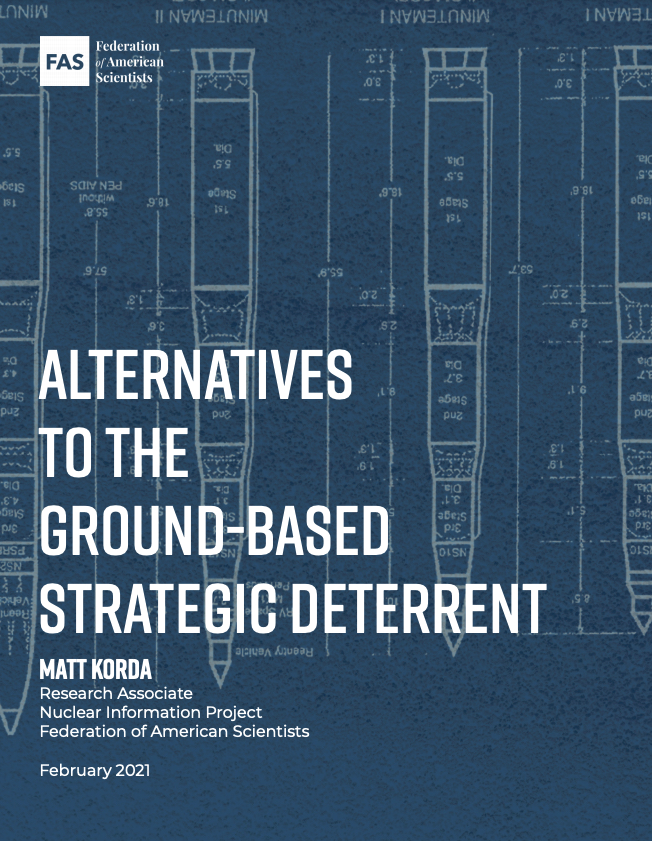
The Treaty on the Prohibition of Nuclear Weapons Enters Into Force Today
The Treaty on the Prohibition of Nuclear Weapons (TPNW) enters into force today, 90 days after the deposit of the 50th instrument of ratification. So far, a total of 86 countries have signed the treaty, which complements existing disarmament measures like the Non-Proliferation Treaty (NPT).
The TPNW is a significant milestone in the long and global effort to achieve a world free from nuclear weapons. The 86 countries that have signed so far are also signatories to the NPT––which also calls for nuclear disarmament––but signed on to the TPNW in apparent frustration over what they consider inadequate progress by the nuclear-armed states in fulfilling their NPT obligations. As we wrote in July 2020, on the 75th anniversary of the Trinity Nuclear Test:
Nuclear-armed states largely do not appear to consider nuclear disarmament to be an urgent global security, humanitarian, or environmental imperative. Instead, most states seem to consider disarmament as a type of chore mandated by the Non-Proliferation Treaty – and not one that they are seriously interested in completing in the foreseeable future.
It is increasingly rare to hear any officials from nuclear weapon states express a coherent rationale for pursuing disarmament other than as a result of the obligation to do so under the Non-Proliferation Treaty. Moreover, they seem increasingly focused on shifting the disarmament responsibility onto the non-nuclear states by arguing they first must create the security conditions that will make nuclear disarmament possible.
The Treaty on the Prohibition of Nuclear Weapons seeks to turn this reality on its head. Rather than listening to another half-century of excuses from the nuclear-armed states that they can’t disarm, the countries behind the TPNW seek to take the initiative and increase pressure on the nuclear-armed states to adopt disarmament measures.
Unfortunately, no matter how many countries sign it, the TPNW does not eliminate any nuclear weapons unless the nuclear-armed states join and implement the treaty’s provisions. They are not legally bound by the prohibition unless they sign the treaty. So far, they have refused, boycotted meetings, and even pressured countries not to sign on. Rather than a ban, they argue that “an incremental, step-by-step approach is the only practical option for making progress towards nuclear disarmament…”
However, decades of trying that approach has left the world with more than 13,000 nuclear weapons, led to a slowed pace of reductions, increasing modernization programs––and in some cases, increasing nuclear arsenals, worsening military tensions, reaffirmations of the enduring role and importance of nuclear weapons, and the discarding of arms control agreements. Non-nuclear armed states would seem justified in wanting to try something new.
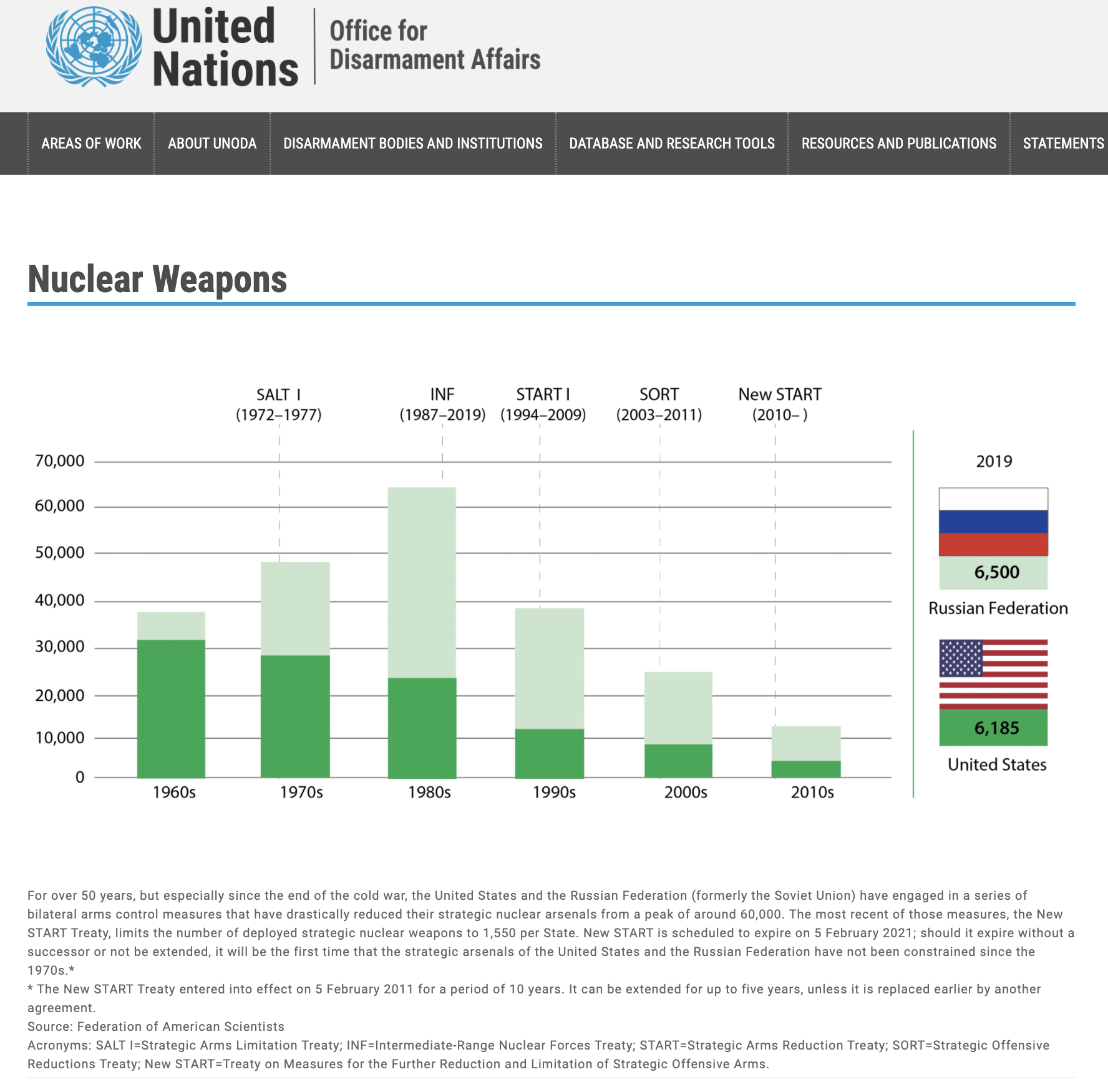
FAS is honored that the United Nations Office for Disarmament Affairs uses our nuclear weapons estimates. For latest updates, go here.
Whether or not one believes the TPNW is the right approach, the Treaty is a reality and now in force. More NPT countries are likely to join. While the Treaty may not immediately create disarmament, it is supported by a significant number of the states party to the NPT. Additionally, the TPNW includes welcome and unprecedented provisions on humanitarian assistance and environmental remediation, which offer a bridge to nuclear-armed states and their allies by allowing them to engage with these provisions without immediately signing the treaty.
Now that the Treaty is in force, instead of continuing to boycott and reject their efforts and motivations of its supporters, the nuclear-armed states must work with them to achieve responsible reductions of nuclear forces and create the conditions that would allow them to be eliminated.
Background Information:
• UN: Treaty on the Prohibition of Nuclear Weapons (TPNW)
• FAS: Status of World Nuclear Forces
The Federation of American Scientists is honored to provide the world with the best non-classified estimates of the nuclear weapons arsenals. We are grateful for the financial support from the New Land Foundation, MacArthur Foundation, Ploughshares Fund, and the Prospect Hill Foundation to do this work. To explore this vast data, developed over many decades, start here.
New NASIC Report Appears Watered Down And Out Of Date
The US Air Force National Air and Space Intelligence Center (NASIC) has published a new version of its widely referenced Ballistic and Cruise Missile Threat report.
The agency normally puts out an updated version of the report every four years. The previous version dates from 2017.
The 2021 report (dated 2020) provides information on developments in many countries but is clearly focused on China, Iran, North Korea, and Russia. Especially the North Korean data is updated because of the significant developments since 2017.
The most interesting new information in the updated report is probably that the new Chinese JL-3 sea-launched ballistic missile (SLBM) is capable of carrying multiple warheads.
Overall, however, the new report may be equally interesting because of what it does not include. There are a number of cases where the report is scaled back compared with previous versions. And throughout the report, much of the data clearly hasn’t been updated since 2018. In some places it is even inconsistent and self-contradicting.
The most significant data reduction is in the cruise missile section where the report no longer lists countries other than Russia, China, and Iran. This is a significant change from previous reports that listed a wide range of other countries, including India and Pakistan and many others that have important cruise missile programs in development. The omission is curious because the report in all ballistic missile categories includes other countries.
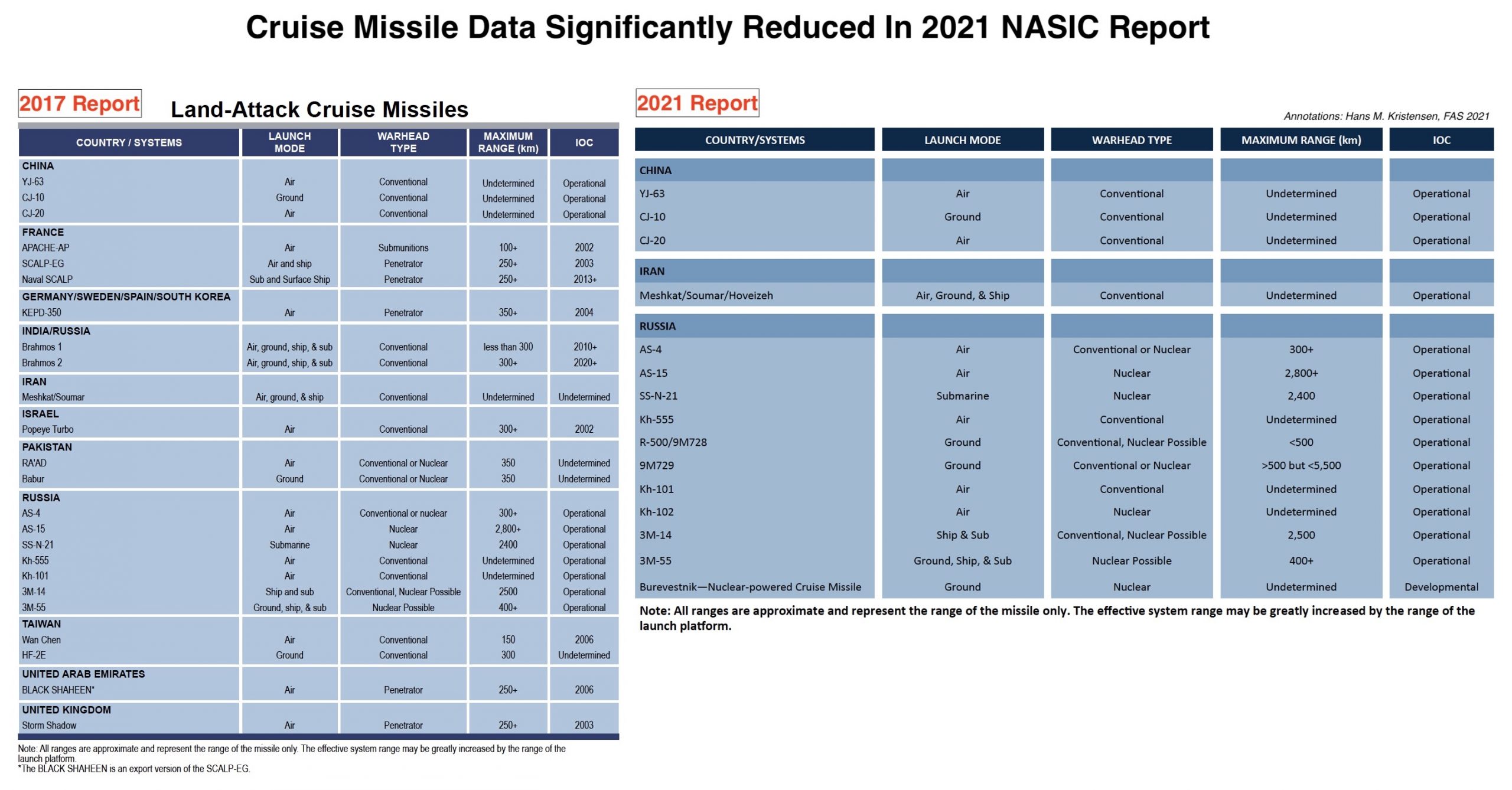
Cruise missile data is significantly reduced in the new NASIC report compared with the previous version from 2017. Click on image to view full size.
Other examples of reduced data include the overview of ballistic missile launches, which for some reason does not show data for 2019 and 2020. Nor is it clear from the table which countries are included.
Also, in some descriptions of missile program developments the report appears to be out of date and not update on recent developments. This includes the Russian SS-X-28 (RS-26 Rubezh) shorter-range ICBM, which the report portrays as an active program but only presents data for 2018. Likewise, the report does not mention the two additional boats being added to the Chinese SSBN fleet. Moreover, the new section with air-launched ballistic missiles only includes Russia but leaves out Chinese developments and only appears to include data up through early 2018.
Whether these omissions reflect changes in classification rules, chaos is the Intelligence Community under the Trump administration, or simply oversight is unknown.
Below follows highlights of some of the main nuclear issues in the new report.
Russian Nuclear Forces
Information about Russian ballistic and cruise missile programs dominate the report, but less so than in previous versions. NASIC says Russia currently has approximately 1,400 nuclear warheads deployed on ICBMs and SLBMs, a reduction from the “over 1,500” reported in 2017. The new number is well known from the release of New START data and is very close to the 1,420 warheads we estimated in our Russian Nuclear Notebook last year.
NASIC repeats the projection from 2017, that “the number of missiles in the Russian ICBM force will continue to decrease because of arms control agreements, aging missiles, and resource constraints….”
The statement that “Russia retains over 1,000 nuclear warheads on ICBMs” is curious, however, because would imply the SLBM force is loaded with fewer warheads than normally assumed. The warhead loading attributed to the SS-N-32 (Bulava) is 6, the number declared by Russia under the START treaty, and less than the 10 warheads that is often claimed by unofficial sources.
The new version describes continued development of the SS-28 (RS-26 (Rubezh) shorter-range ICBM suspected by some to actually be an IRBM. But the report only lists development activities up through 2018 and nothing since. The system is widely thought to have been mothballed due to budget constraints.
The cruise missile section attributes nuclear capability – or possible nuclear capability – to most of the Russian missiles listed. Six systems are positively identified as nuclear, including the Kh-102, which was not listed in the 2017 report. Two of the nuclear systems are dual-capable, including the 9M729 (SSC-8) missile the US said violated the now-abandoned INF treaty, while 3 missiles are listed as “Conventional, Nuclear Possible.” That includes the 9M728 (R-500) cruise missile (SSC-7) launched by the Iskander system, the 3M-14 (Kalibr) cruise missile (SS-N-30), and the 3M-55 (Yakhont, P-800) cruise missile (SS-N-26).

NASIC attributes nuclear capability to nine Russian land-attack cruise missiles, three of them “possible.” Click on image to view full size.
The designation of “nuclear possible” for the SS-N-30 (3M-14, often called the Kalibr even though Kalibr is strictly speaking the name of the launcher system) is curious because the Russian government has clearly stated that the missile is nuclear-capable.
Chinese Nuclear Forces
The biggest news in the China section of the NASIC report is that the new JL-3 SLBM that will arm the next-generation Type 096 SSBN will be capable of delivering “multiple” warheads and have a range of more than 10,000 kilometers. That is a significant increase in capability compared with the JL-2 SLBM currently deployed on the Jin-class SSBNs and is likely part of the reason for the projection that China’s nuclear stockpile might double over the next decade.

NASIC reports that China’s next-generation JL-3 SLBM will be capable of carrying “multiple” warheads. Click on image to view full size.
Despite this increased range, however, a Type 096 operating from the current SSBN base in the South China Sea would not be able to strike targets in the continental United States. To be able to reach targets in the continental United States, an SSBN would have to launch its missile from the Bohai Sea. That would bring almost one-third of the continental United States within range. To target Washington, DC, however, a Type 096 SSBN would still have to deploy deep into the Pacific.
The new DF-41 (CSS-20) has lost its “-X-“ designation (CSS-X-20), which indicates that NASIC considers the missile has finished development is now being deployed. A total of 16+ launchers are listed, probably based on the number attending the 2019 parade in Beijing and the number seen operating in the Jilantai training area.
The number of DF-31A and DF-31AG launchers is very low, 15+ and 16+ respectively, which is strange given the number of bases observed with the launchers. Of course, “+” can mean anything and we estimate the number of launchers is probably twice that number. Also interesting is that the DF-31AG is listed as “UNK” (unknown) for warheads per missile. The DF-31A is listed with one warhead, which suggests that the AG version potentially could have a different payload. Nowhere else is the AG payload listed as different or even multiple warheads.
The NASIC report projection for the increase in Chinese nuclear ICBM warheads that can reach the United States is inconsistent and self-contradicting. In one section (p. 3) the report predicts “the number of Chinese ICBM nuclear warheads capable of reaching the United States potentially expanding to well over 200 within the next 5 years.” But in another section (p. 27), the report states that the “number of warheads on Chinese ICBMs capable of threatening the United States is expected to grow to well over 100 in the next 5 years.” The projection of “well over 100” was also listed in the 2017 report, and the “well over 200” projection matches the projection made in the DOD annual report on Chinese military developments. So the authors of the NASIC might simply have forgotten to update the text.
On Chinese shorter-range ballistic missiles, the NASIC report only mentions DF-21A (CSS-5 Mod 2) as nuclear, but not the CSS-5 Mod 6 version. The Mod 6 version (potentially called DF-21E) was first mentioned in the 2016 DOD report on Chinese military developments and has been included since.
Newer missiles finally get designations: The dual-capable DF-26 is called the CSS-18, and the conventional (possibly) DF-17 is called the CSS-22. NASIC continues to list the DF-26 range as less (3,000+ km) than the annual DOD China report (4,000 km).
An in case anyone was tempted, no, none of China’s cruise missiles are listed as nuclear-capable.
Pakistani Nuclear Forces
The report provides no new information about Pakistani nuclear-capable ballistic missiles. As with several other sections in the report, the information does not appear to have been updated much beyond 2018, if at all. As such, status information should be read with caution.
The Shaheen-III MRBM is still not deployed, nor is the Ababeel MRBM that NASIC describes as a “MIRV version.” It has only been flight-tested once.
The tactical nuclear-capable NASR is listed with a range of 60 km, the same as in 2017, even though the Pakistani government has since claimed the range has been extended to 70 km.
Because the new NASIC report no longer includes data on Pakistan’s cruise missiles, neither the Babur nor the RAAD programs are described. Nor is any information provided about the efforts by the Pakistani navy to develop a submarine-launched nuclear-capable cruise missile.
Indian Nuclear Forces
Similar to other sections of the report, the data on Indian programs are tainted by the fact that some information does not appear to have been updated since 2018, and that the cruise missile section does not include India at all.
According to the report, Agni II and Agni III MRBMs are still deployed in very low numbers, fewer than 10 launchers, the same number reported in 2017. That number implies only a single brigade of each missile. But, again, it is not clear this information has actually been updated.
Nor are the Agni IV or the Agni V listed as deployed yet.
North Korean Forces
The North Korean sections are main interesting because of the inclusion of data on several systems test-launched since the previous report in 2017. This contrasts several other data set in the report, which do not appear to have been updated past 2018. But since the North Korean long-range tests occurred in 2017, this may explain why they are included.
NASIC provides official (unclassified) range estimates for these missiles:
The Hwasong-12 IRBM range has been increased from 3,000+ km in 2017 to 4,500+ km in the new report.
On the ICBMs, the Taepo Dong 2 no longer has a range estimate. The Hwasong-13 and Hwasong-14 range estimates have been raised from the generic 5,500+ km in the 2017 report to 12,000 km and 10,000+ km, respectively, in the new report, and the new Hwasong-15 has been added with a range estimate of 12,000+ km. The warhead loading estimates for the Hwasong-14 and Hwasong-15 are “unknown” and none of the ICBMs are listed as deployed.
On submarine-launched missiles, the NASIC report lists two: the Puguksong-1 and Pukguksong-3. Both have range estimates of 1,000+ km and the warhead estimate for the Pukguksong-3 is unknown (“UNK”). Neither is deployed. The new Pukguksong-4 paraded in October 2020 is not listed, not is the newest Pukguksong-5 displayed in early 2021 mentioned.
Additional background information:
• Russian nuclear forces, 2020

